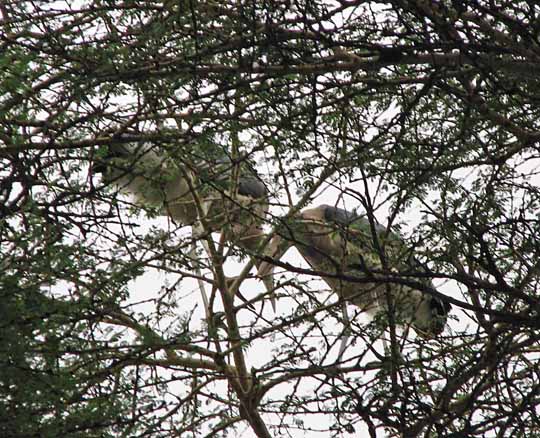
Mount Kenya
So off we go on the way to our first stop, the Mount Kenya Mountain Park and the Serena Mountain Lodge. As you read in the Kenya introduction about the roads and scenes along the roads, we'll skip right to the Park.
OK, we were very naive about what we might see, so at the hotel that morning as we prepared to leave, someone shouts, "look up in the tree - huge birds." So I'm not alone running out on the parking area to take pictures. The "huge birds" were actually storks - not a big deal. But what the hell, I'm not going to miss a picture of "wild life", so click, click!

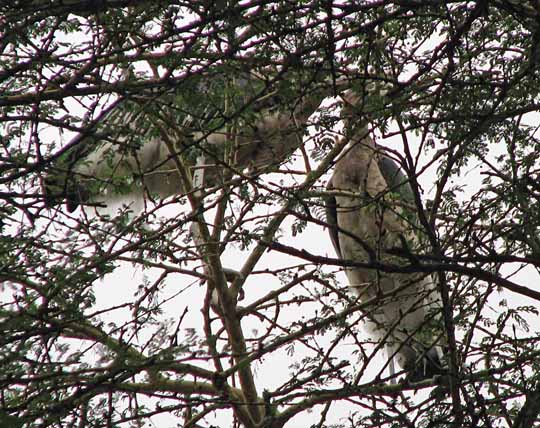
Off we go - on the way to the park.
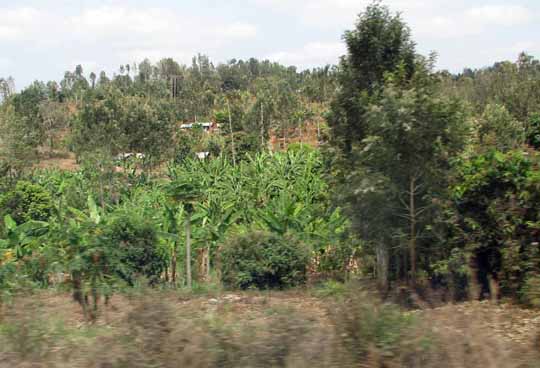 We
pass bananas being cultivated.
We
pass bananas being cultivated.
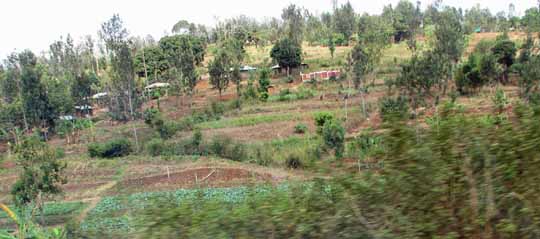
Well cared for crops on small fields
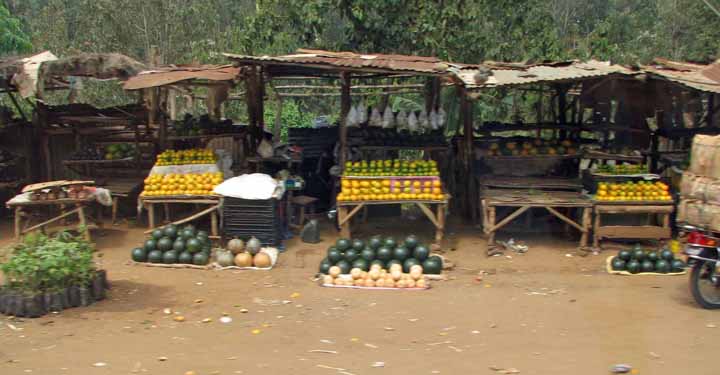
Produce from those fields being sold at road side stands
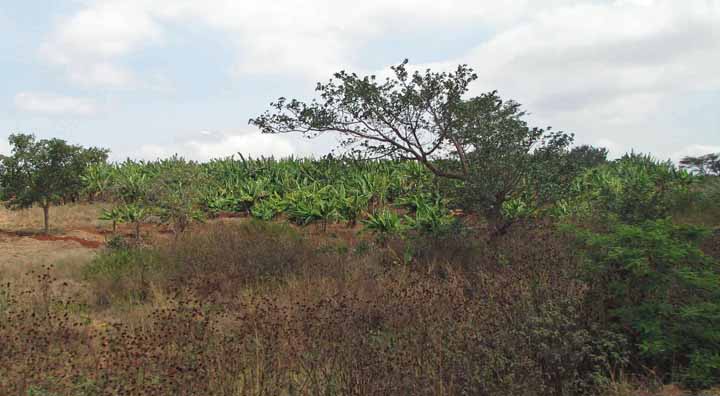
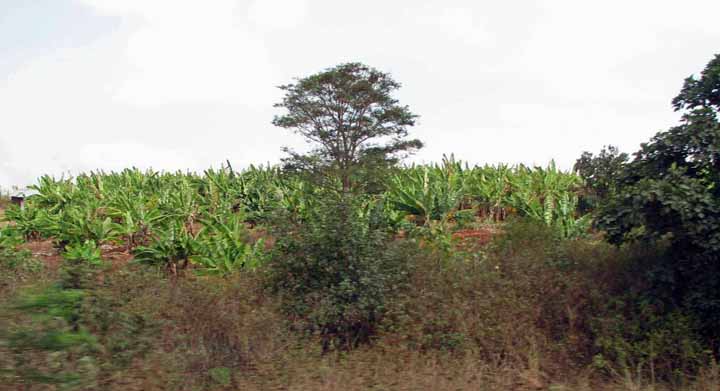
More bananas
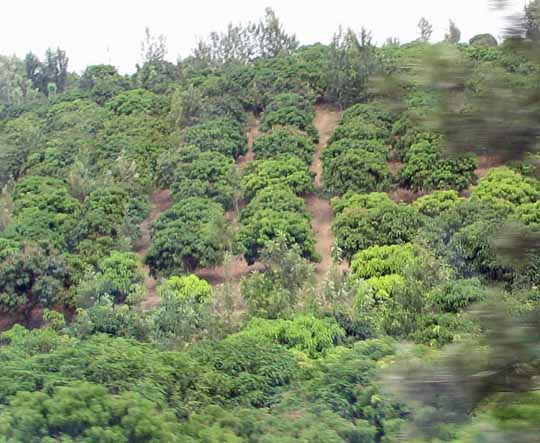 Tea
Tea
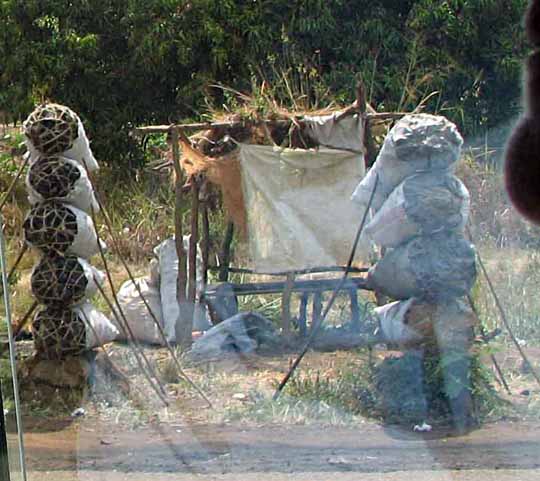 Charcoal
Charcoal
A road side shady spot / rest area.
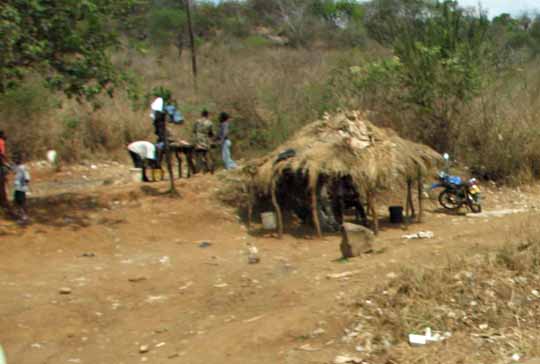 More bananas
More bananas
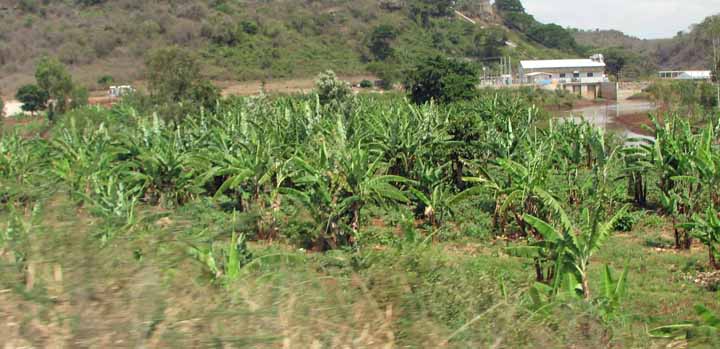
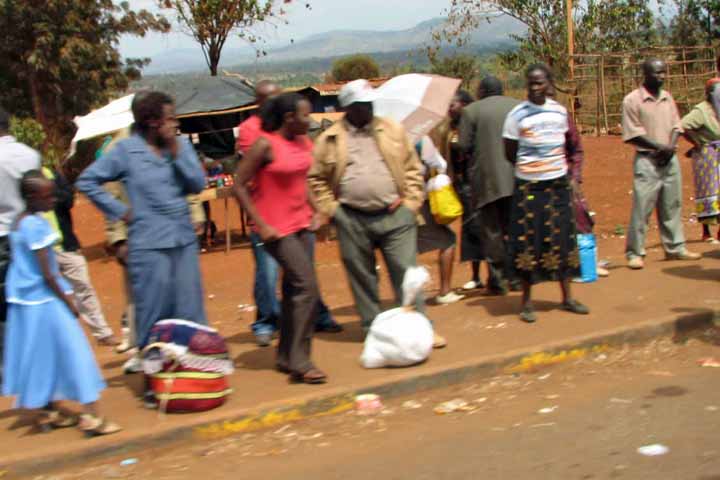 Waiting
for the van for a trip to town
Waiting
for the van for a trip to town
Cows everywhere, as are hundreds of goats -
we will grow used to these wandering
in the field as well as being herded along road sides. 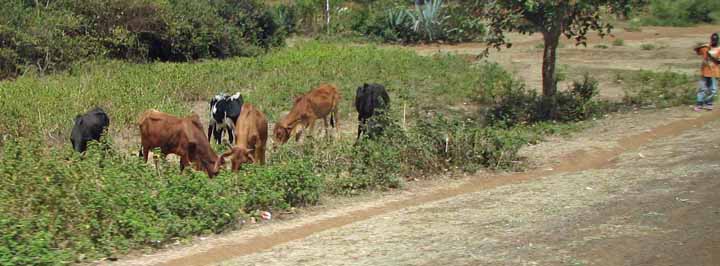
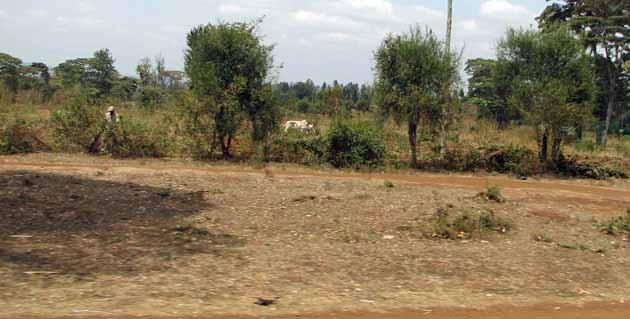 Not the most pleasant work
Not the most pleasant work
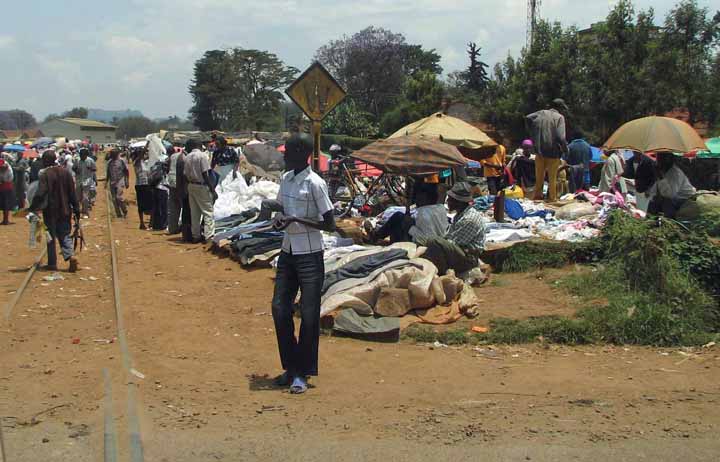
Market Day at this town
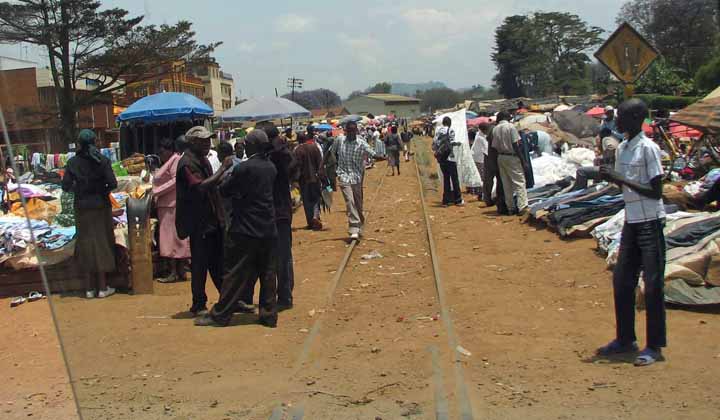
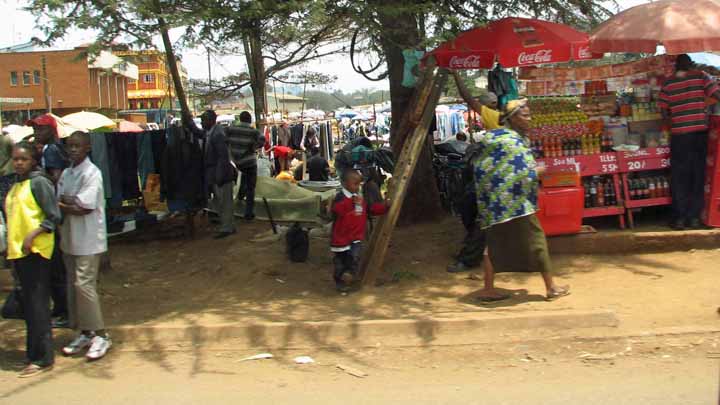
A road side store
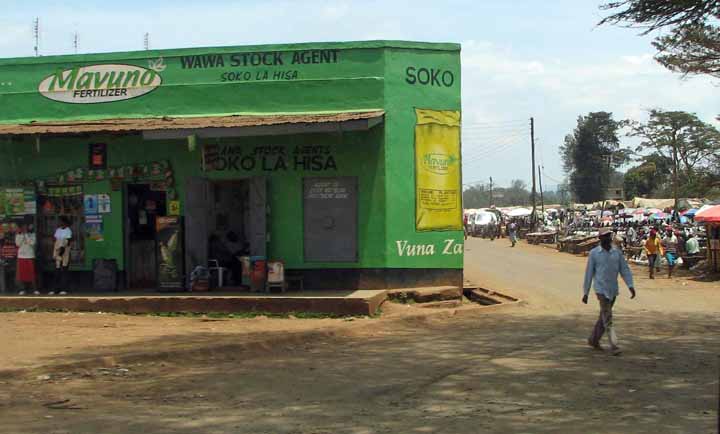
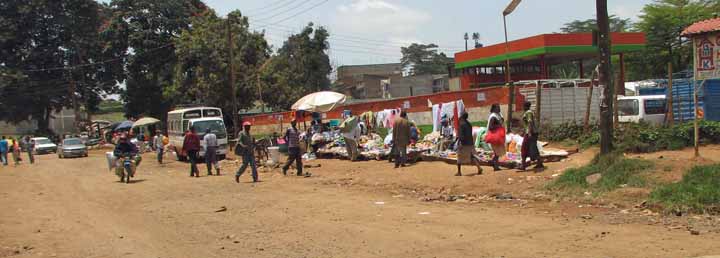 Vendors
along the road
Vendors
along the road
We enter the Park
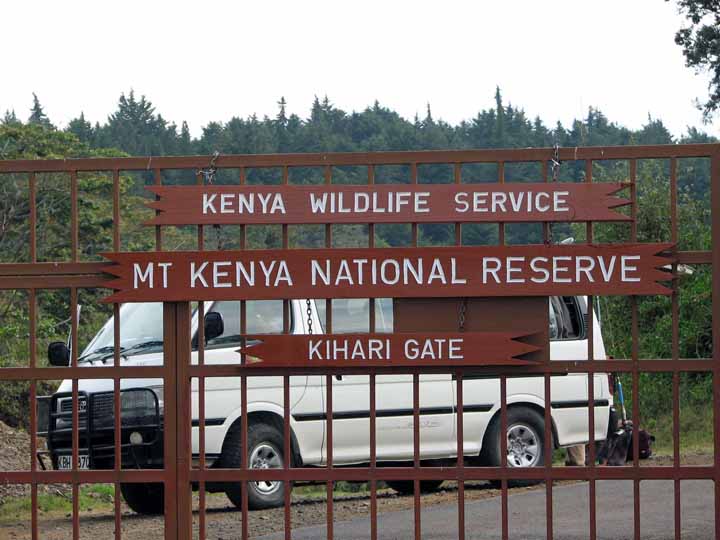
and drive up to the lodge
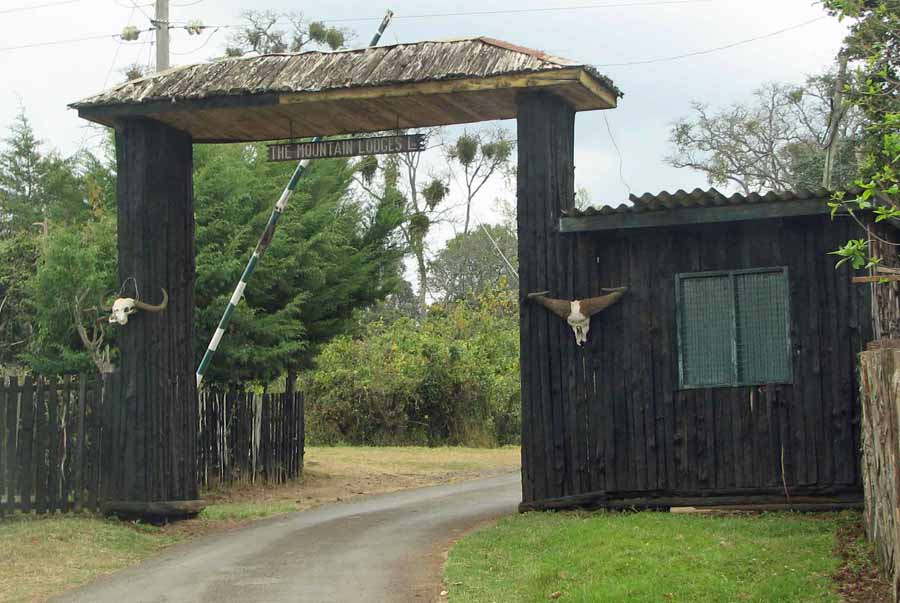
None of us have been on "safari" before, and I don't have any idea what to expect. So we, or at least I, get out of the van in the gravel lot and see nothing but a tall gray/green fence. The initial hustle and bustle as we get out; porters come up to get our bags is distracting.
~ ~ ~ ~ ~ ~ ~ ~ ~ ~ ~ ~
Note: At every stop, and before every departure from every lodge, we are greeted by porters. They carry the luggage to the reservation desk and others carry them from there to your room - where they take a moment to share a few rules with us - such as, "Keep your doors locked; the monkeys know how to unzip and unpack your luggage and are very pleased to steal food or anything that catches their eye or peaks their curiosity. Keep your windows tightly shut when not in the room."
The morning scheduled for you to leave, porters are anxiously waiting outside the building or in the hall ready for your departure. They politely vie for your luggage with each other, and carry it to the reservation desk. Then, as the vans pull up, they carry the luggage to the van.
Now the lessons here are: 1) be ready to go when ever luggage is to be moved. 2) Most important - make certain that you bring a large number of $1.00 USD bills. We suggest about $120 in ones to tip the porters. On our 12 days we spent at least that amount at $1.00 per bag per carry - not counting the tips left for house keeping staff - who, by the way, did a superior job at every single lodge!
~ ~ ~ ~ ~ ~ ~ ~ ~ ~ ~ ~
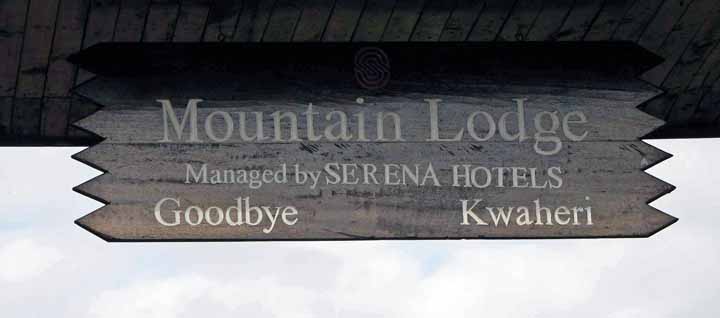
So, we're out of the van, in a gravel lot surrounded by a tall fence. We look up and the first thing we see, less than 6 feet away, are monkeys.
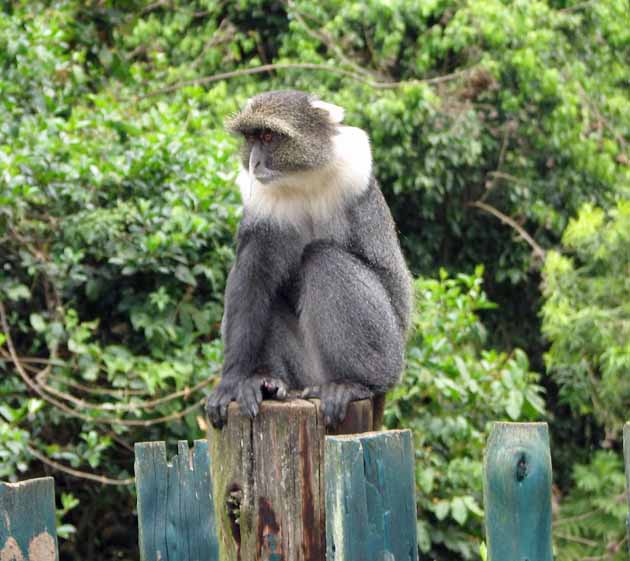
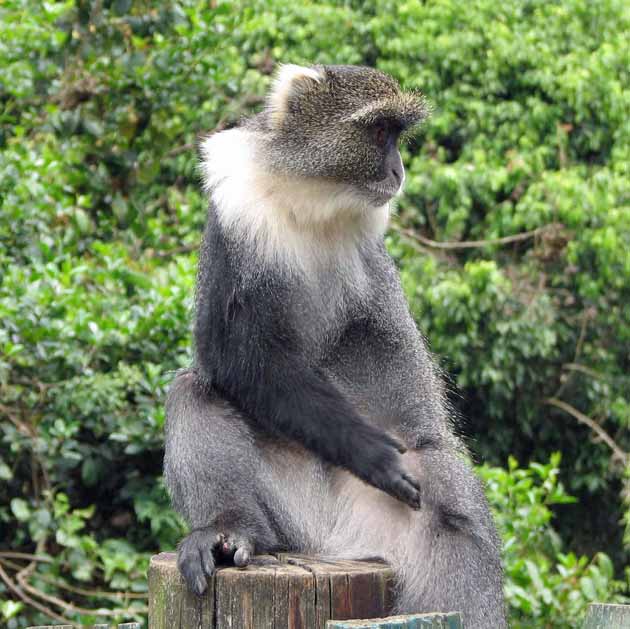
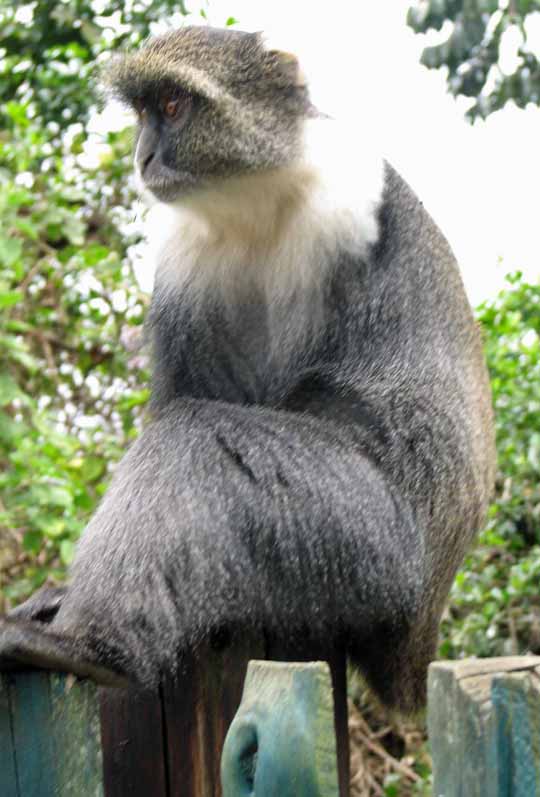
The guide from the hotel says, "Look out for these little guys; these monkeys are quite cheeky." So from that point on, I feel compelled to say when around any and all monkeys, "Cheeky little minkeys." ("Minkey" is from Inspector Clouseau, the Pink Panther series of movies, of course.) I'm certain Jackie got very, very tired of my descriptors. This is a Sykes monkey.
Now we walk down a long gravel pathway, surrounded on both sides with a 6 foot solid wood fence. I'm irritated because the walk is longer than I thought necessary and the fence keeps one from looking at the scenery. Pretty snobbish of me, eh?
Around a turn and there is the lodge. It is a greenish wooden structure that appears to be at least three stories tall. Just before the walk up the incline to the doorway, on the right, there is a sign.
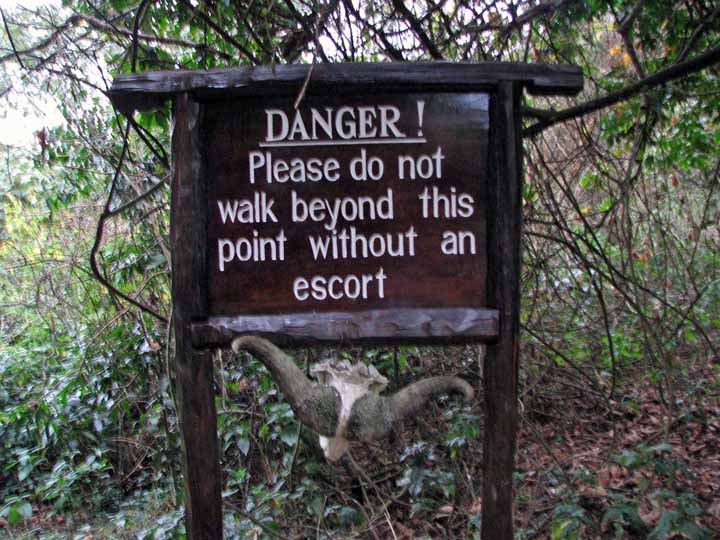
Good advice, we later learn!
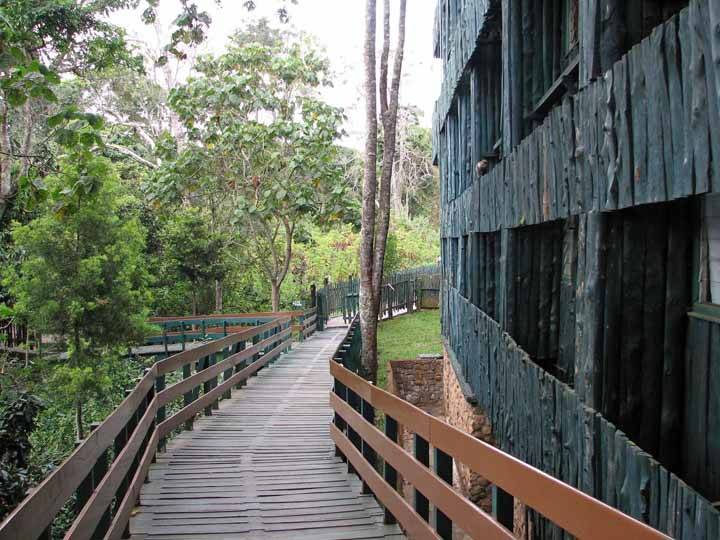
Looking back at the walk up to the lodge.
The Serena Mountain Lodge is about 40 years old. It appears to be all wood, and I have to admit, fits in very well with the environment. Here are some views of the lodge and our room.

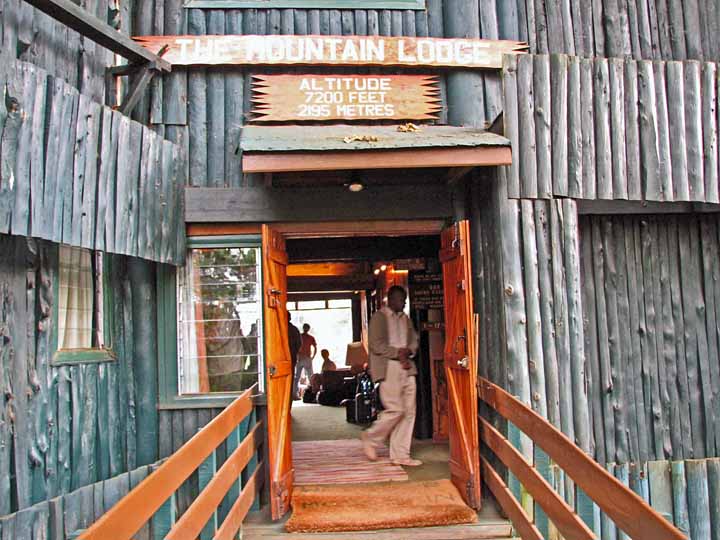
The entrance - look through and you'll see the large glass viewing area.
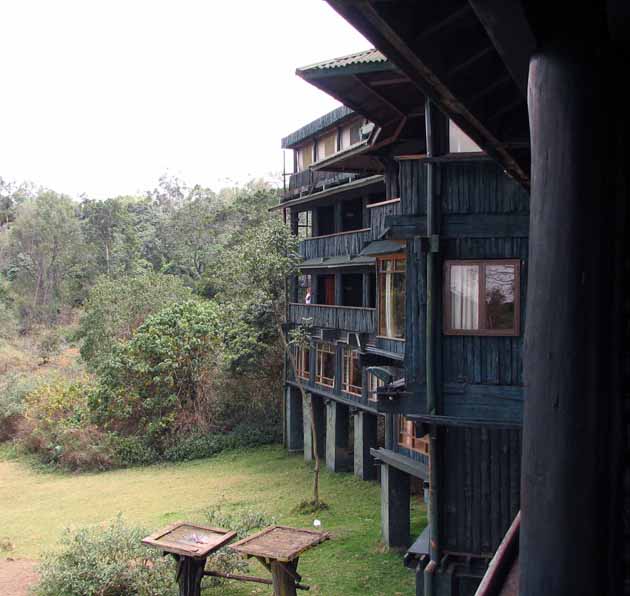 The
"back" of the lodge. Every room faces the watering hole - each
with a double glass door and balcony.
The
"back" of the lodge. Every room faces the watering hole - each
with a double glass door and balcony.
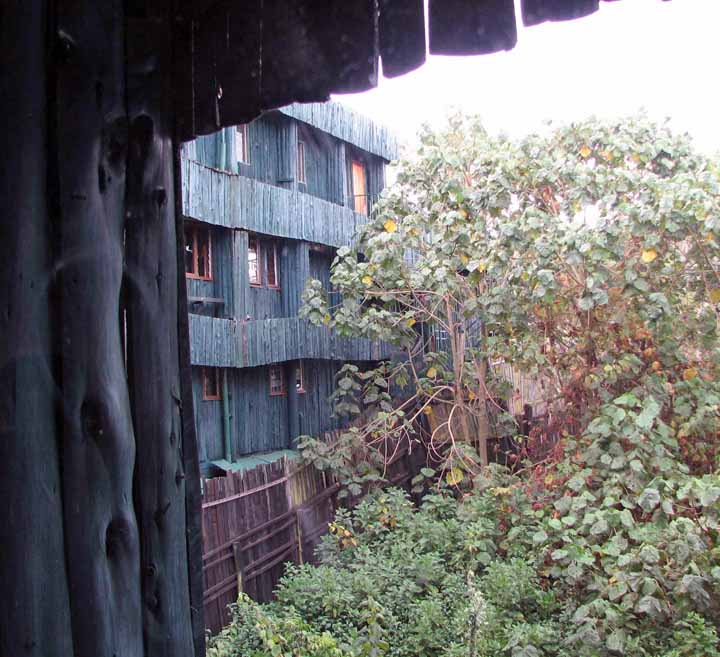
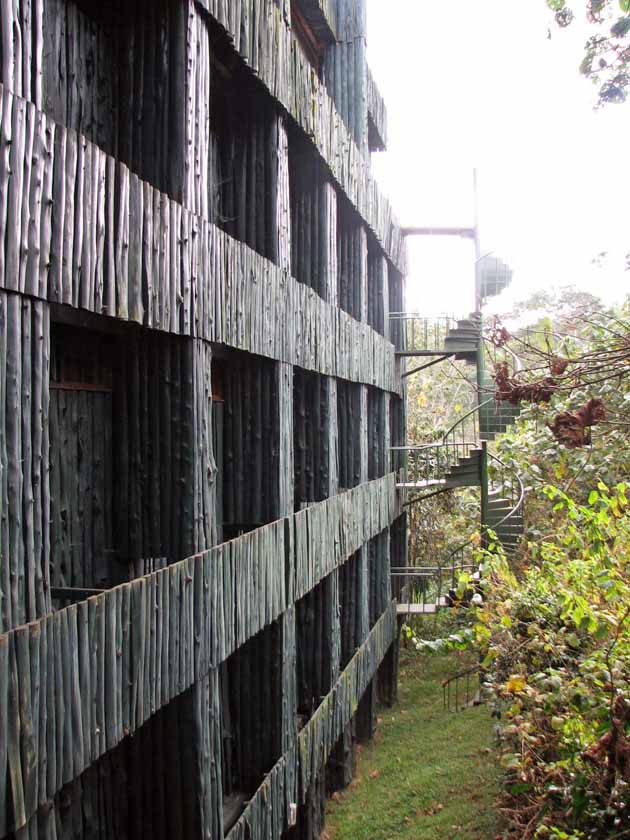
The "front" of the building, seen as one walks up to the lodge
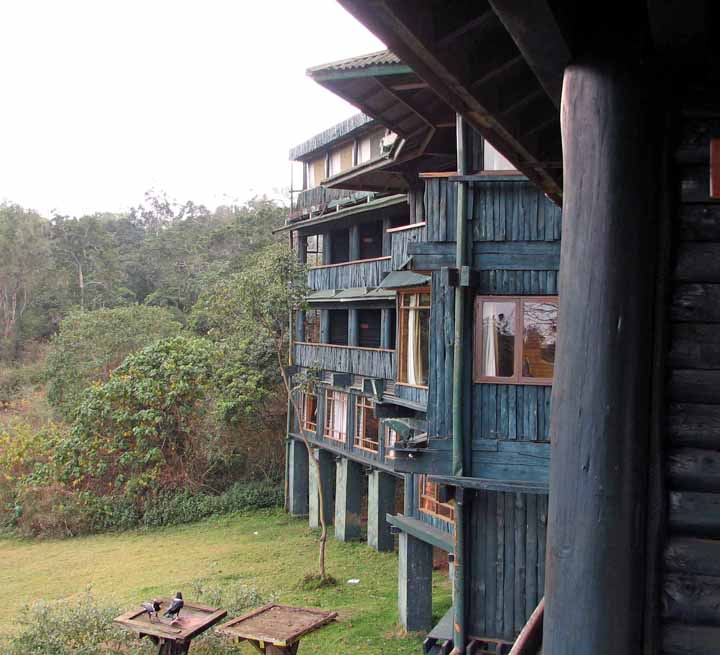
Another view of the balconies
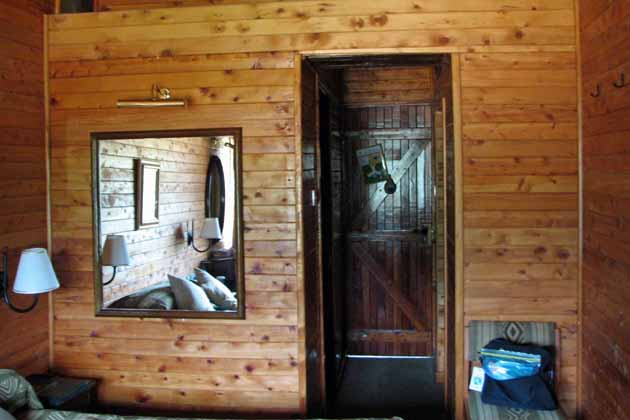 Entrance
to our room.
Entrance
to our room.
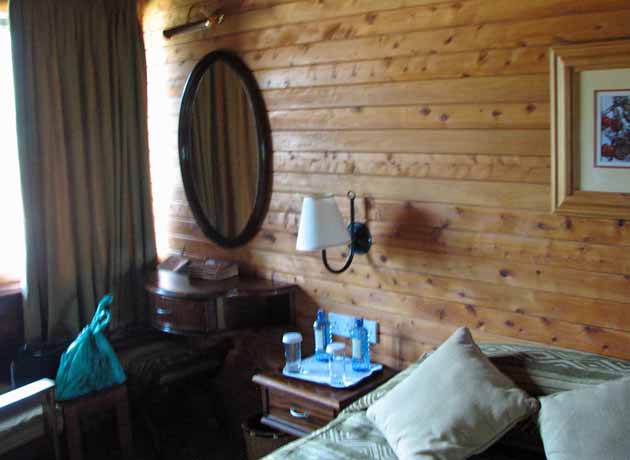 The bedroom.
The bedroom.
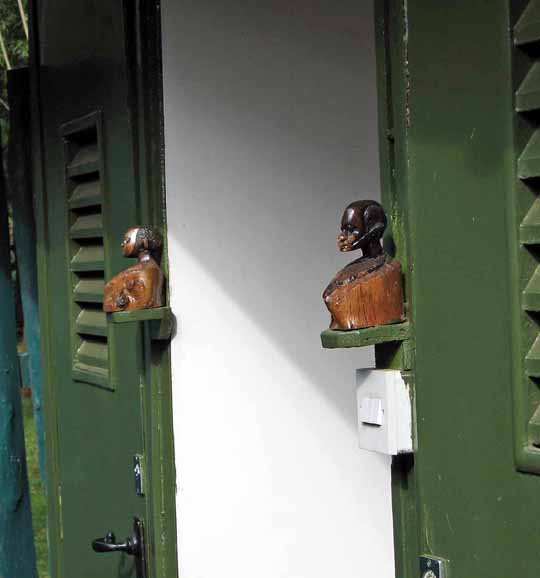
The identification of guest bathrooms in the lobby
As we walk into the lobby, we see the far wall is almost completely glass and people are seated looking out the windows at the watering hole.
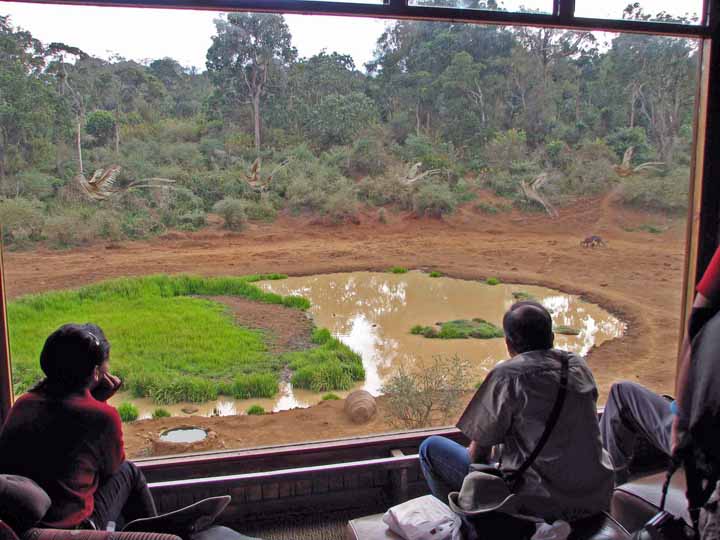
The next thing I know, Jackie is shouting, "Elephants" and she trots over to the window. And there are the elephants. The first wild animals we see ( other than cheeky minkeys...) just happen to be Jackie's favorite, and this proves to be a good omen for the trip as well as both a blessing and an hindrance.
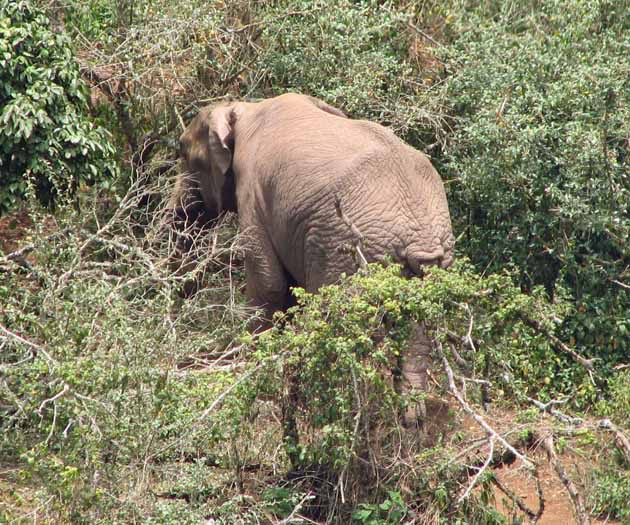
This lodge is famous for its watering hole. All rooms face the watering hole and each room has a spacious balcony and wide shelf attached to the banister. Before we leave we are all very, very familiar with our balconies.
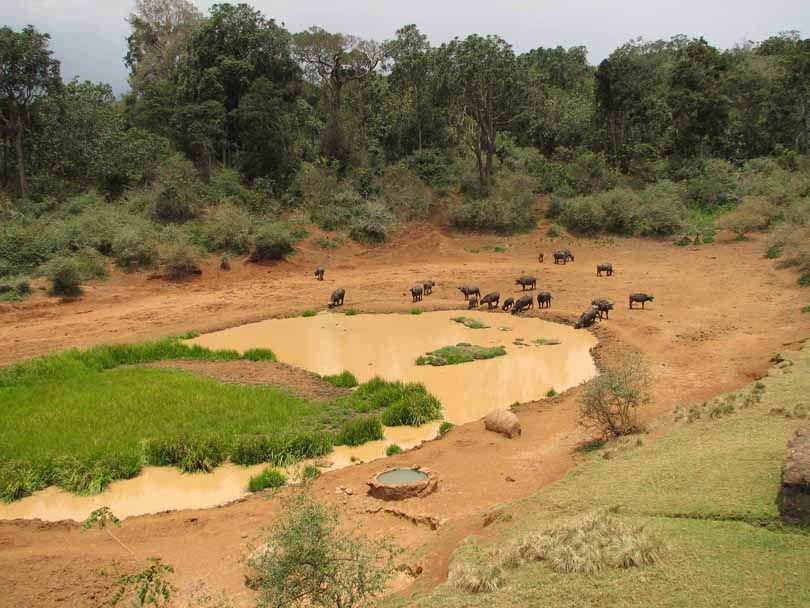
The very famous and much discussed Serena Mountain Lodge Watering Hole
After taking a couple pictures of each other, as Pam & Charles are in the next room / balcony, we chase a couple monkeys off our balcony, and start watching the water hole.
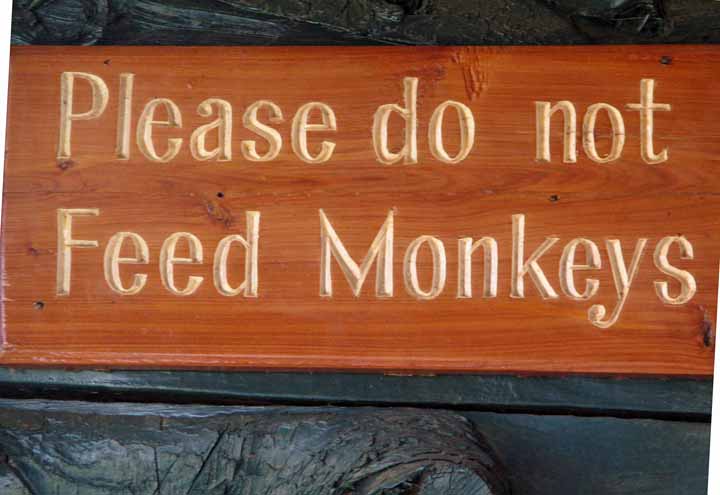
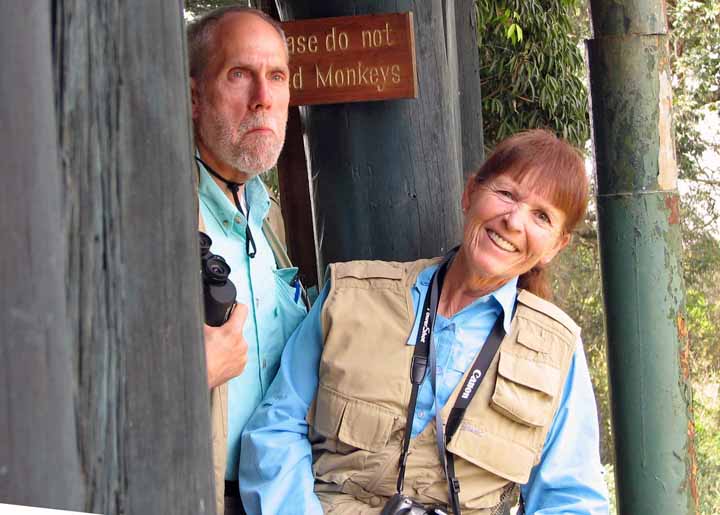
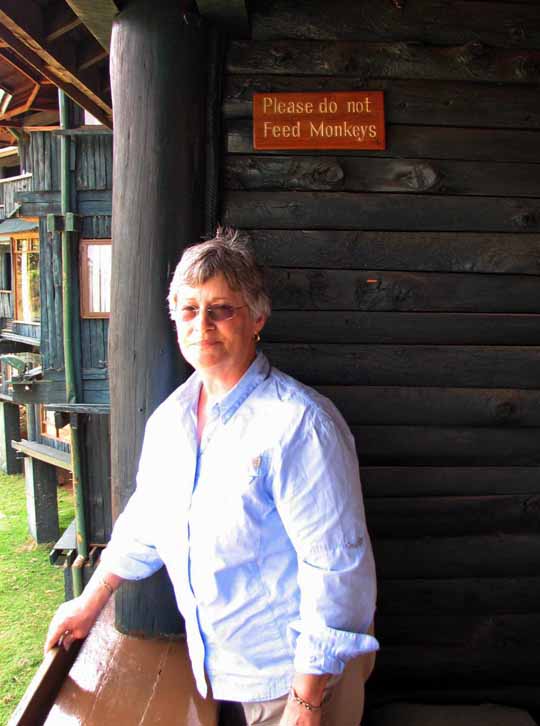
And the animals start arriving, leaving, wandering around, hiding in the brush and often being exceptionally difficult to photograph.
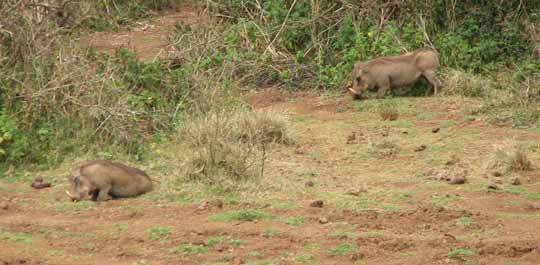
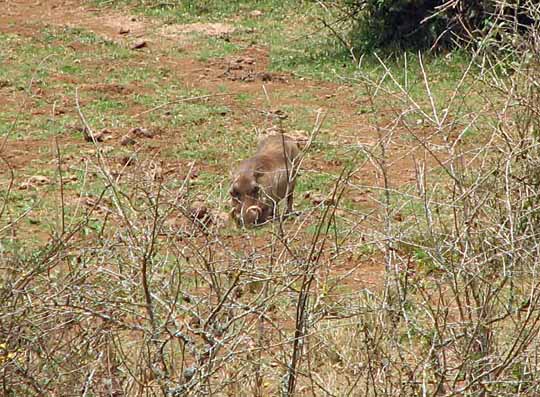
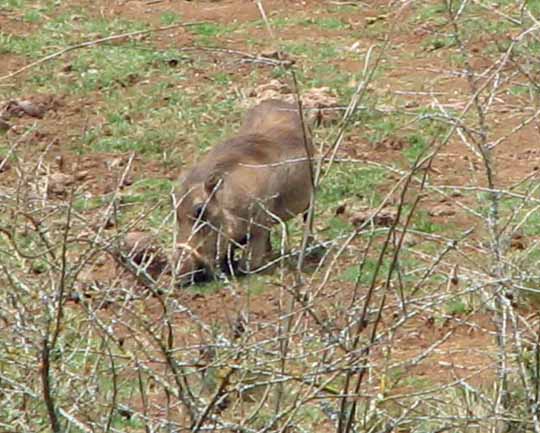 Actually, after
the lone elephant, we saw in the distance - in the bush - a pair of wart
hogs. Oh the excitement! Wild animals in the wild - first day in
Kenya. Just had to take pictures! Wasted more film and effort being
excited and not knowing what, if any, animals we might next see.
Actually, after
the lone elephant, we saw in the distance - in the bush - a pair of wart
hogs. Oh the excitement! Wild animals in the wild - first day in
Kenya. Just had to take pictures! Wasted more film and effort being
excited and not knowing what, if any, animals we might next see.
Yes - These are CAPE Buffalo - not WATER Buffalo -
No need to correct me again Hodge!
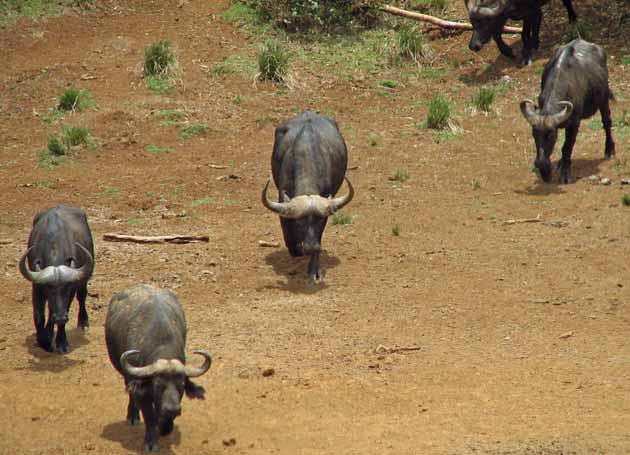
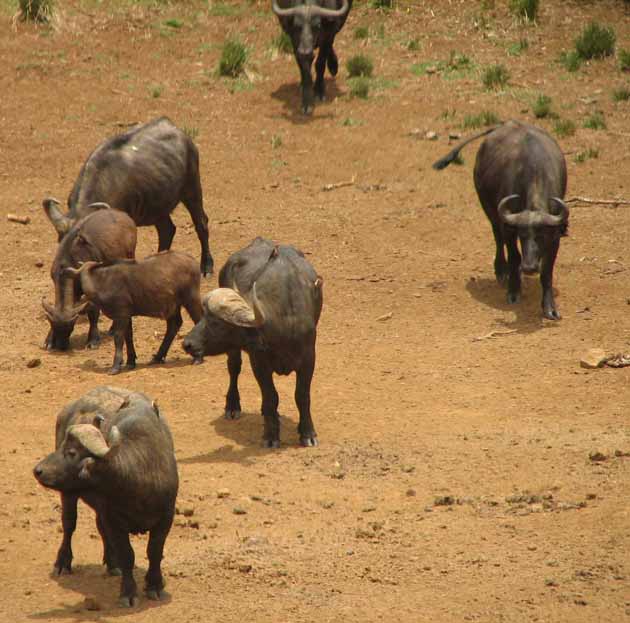
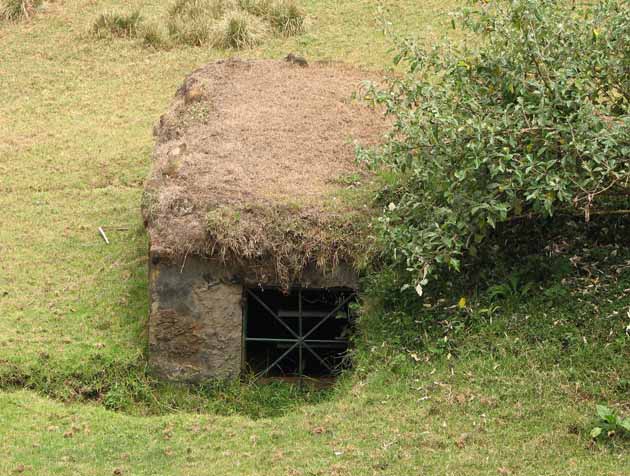 A
really neat thing about the lodge is this "underground" viewing
area. One goes down the stairs to the end, out a passage to the viewing
area and can view / photograph the animals up close.
A
really neat thing about the lodge is this "underground" viewing
area. One goes down the stairs to the end, out a passage to the viewing
area and can view / photograph the animals up close.
 This small platform was very close to our balcony. I thought it was
for
birds of prey, but boy was I wrong.
This small platform was very close to our balcony. I thought it was
for
birds of prey, but boy was I wrong.
You'll notice below, the wire holding the bones to the platform - there's a reason for the wire.

And these birds are not the reason
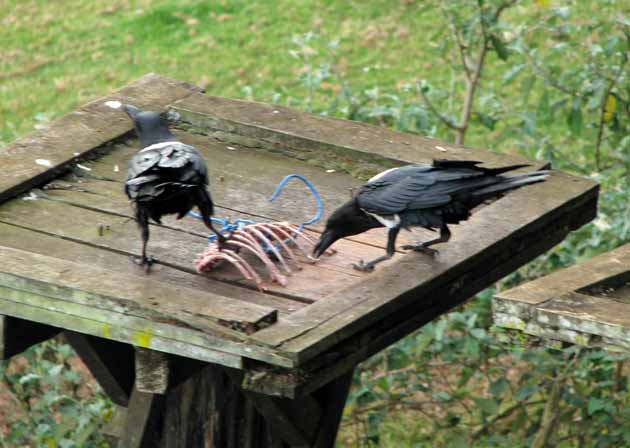
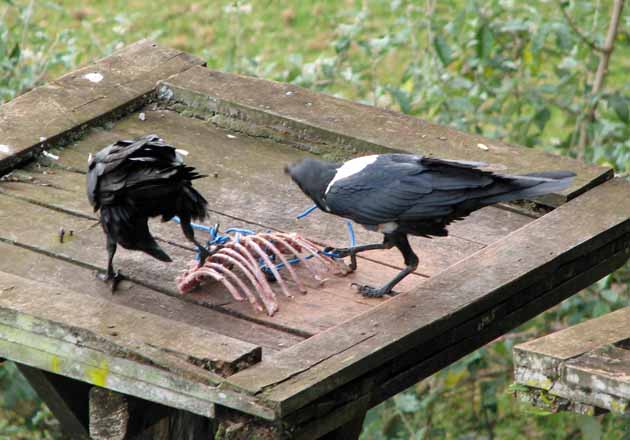
Some deer wander out
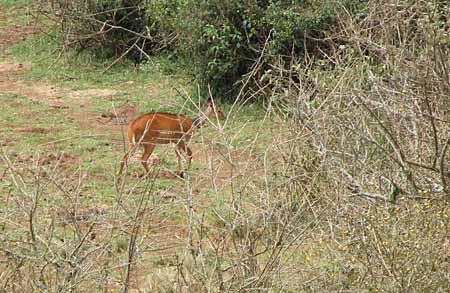
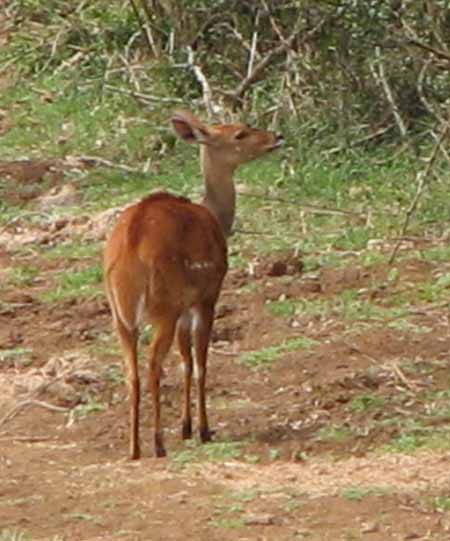
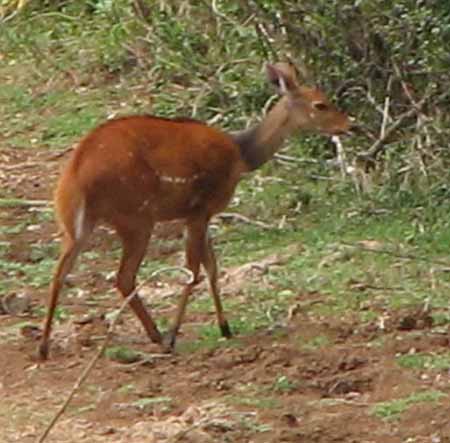
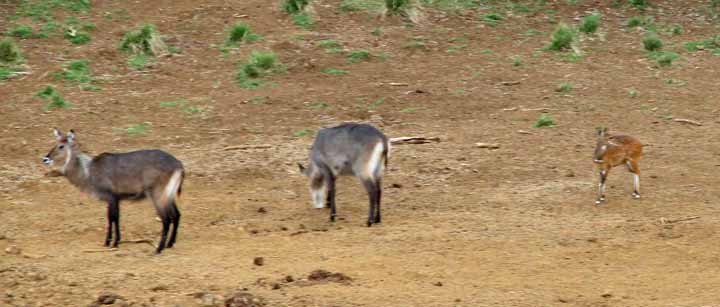
And the hogs are back to get a few more bites before dark
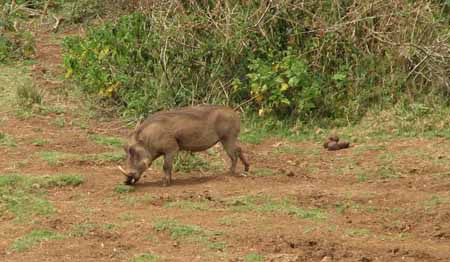
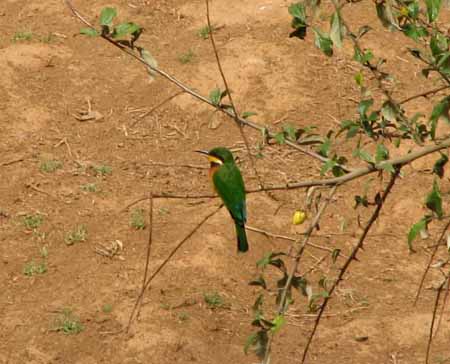 We
saw the prettiest bird - brilliant green wings in flight, but difficult for me
to photograph. Had to settle for these shots.
We
saw the prettiest bird - brilliant green wings in flight, but difficult for me
to photograph. Had to settle for these shots.

And There Were Elephants!
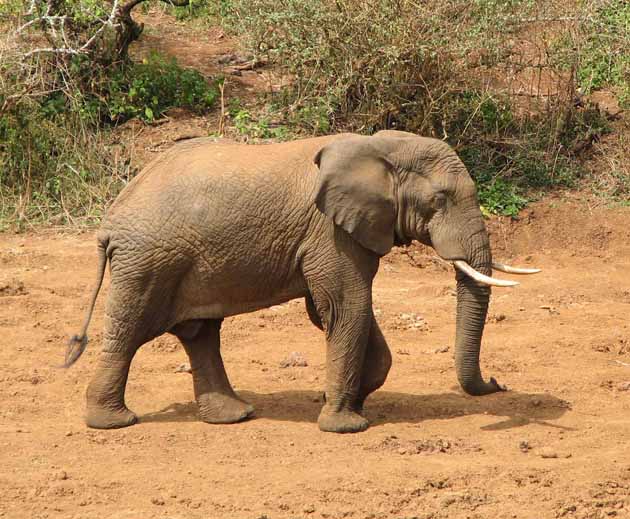
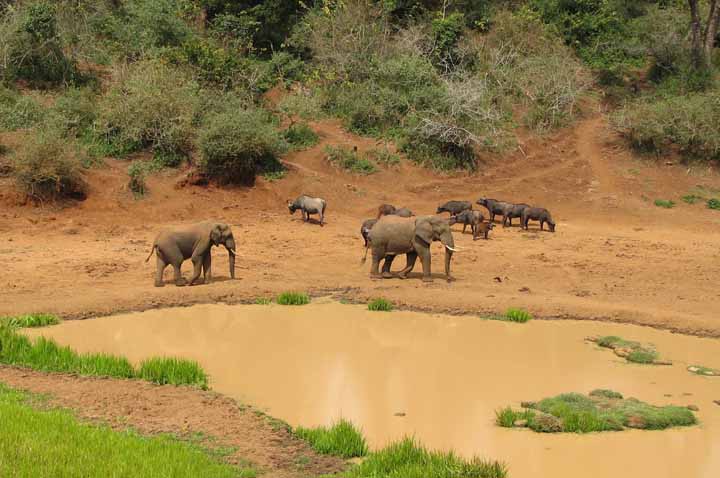
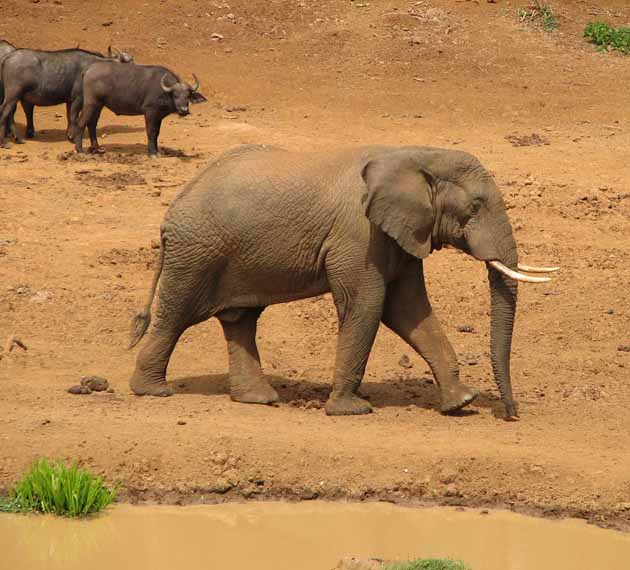
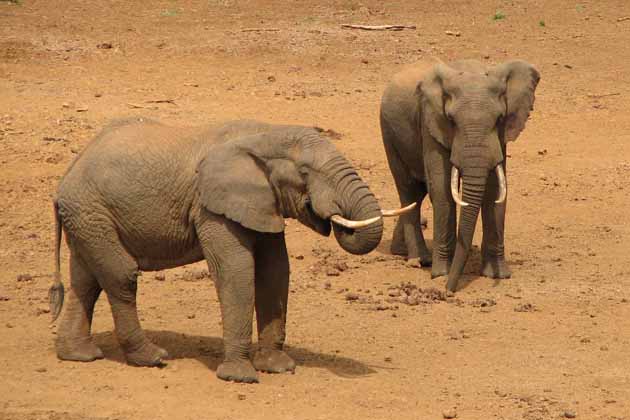
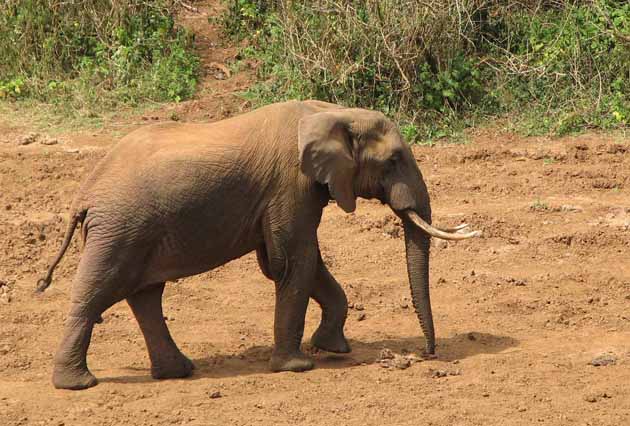

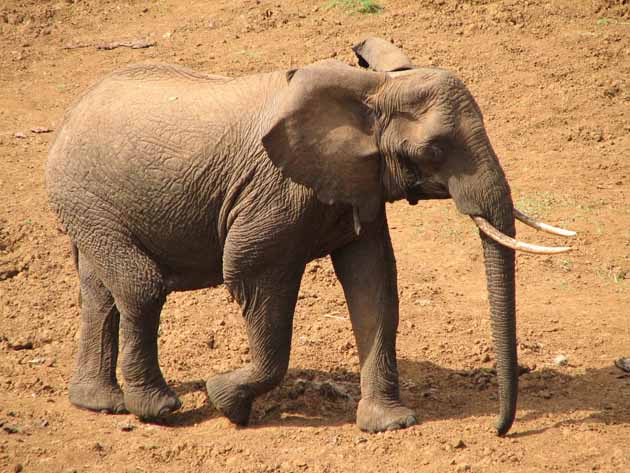
As we found out during the trip - this was often the view we saw of many animals -
We got a lot of "butt shots"
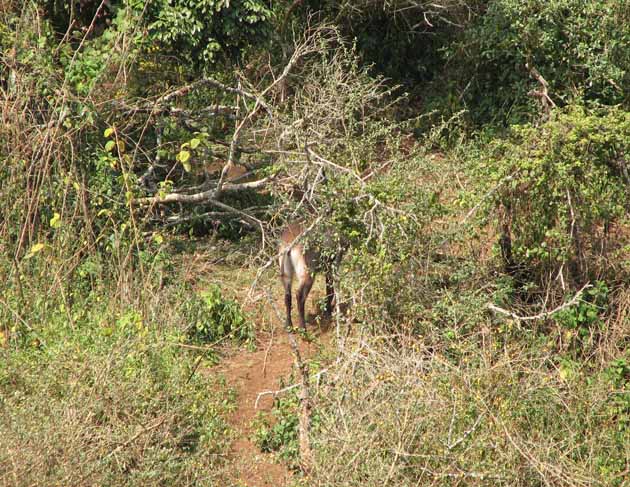
Oh, there were some breaks from elephants.....
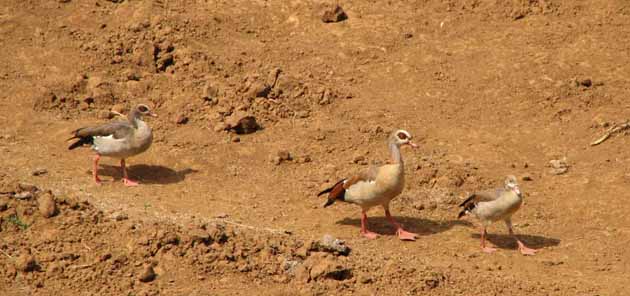
But not much - And you can't have too many elephants, can you?
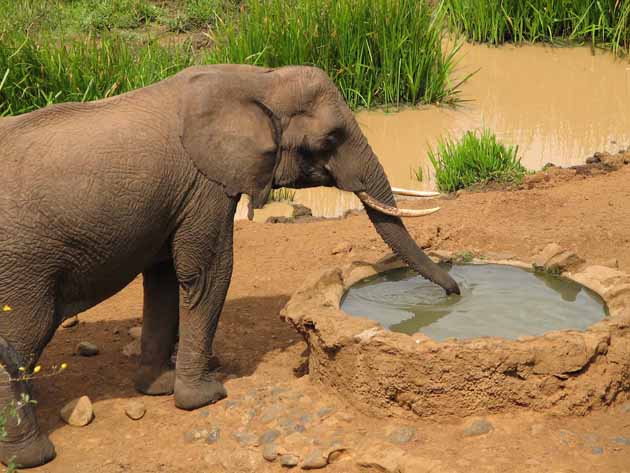
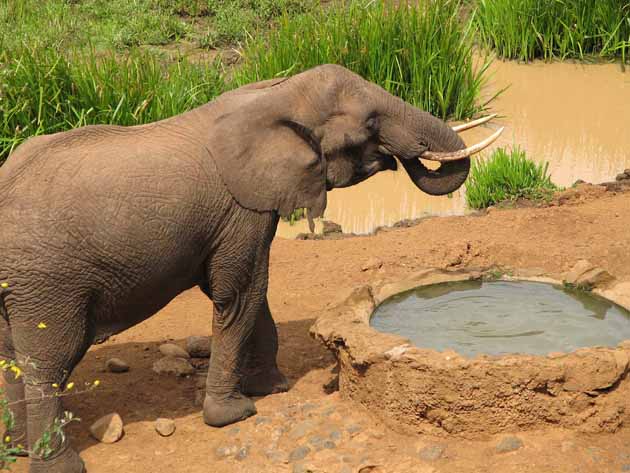
And then there were the little guys - No matter how many times one sees the baby elephants,
there's that "Oh" and "Aw"
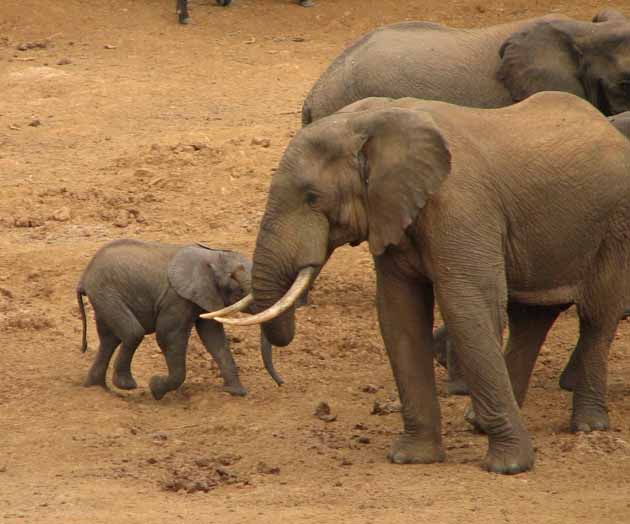
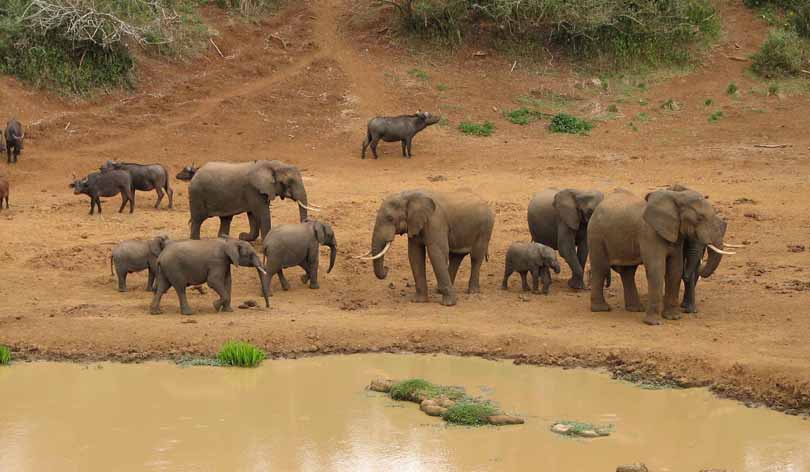
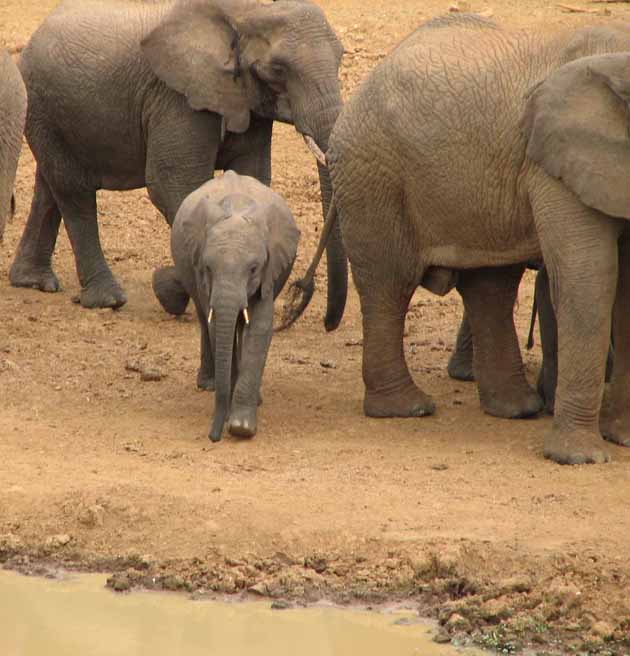
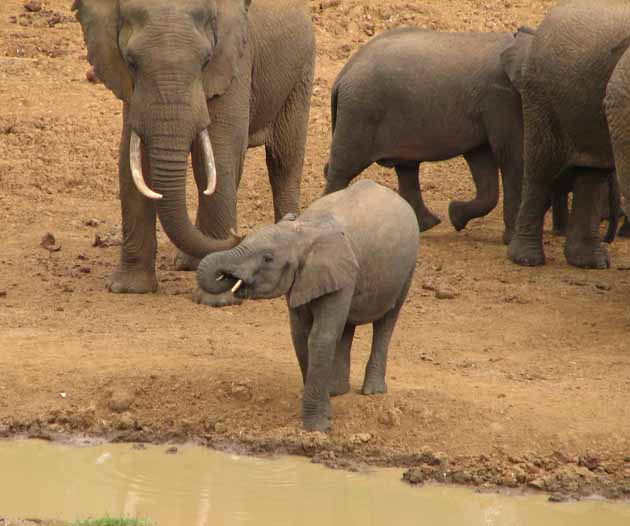
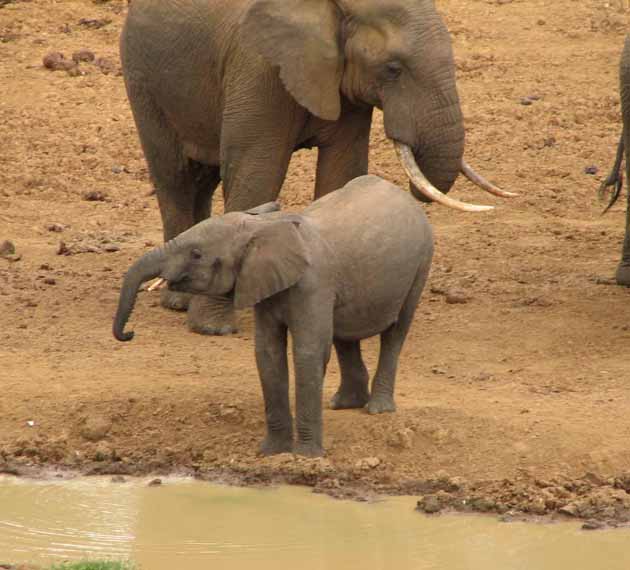
All sizes and ages
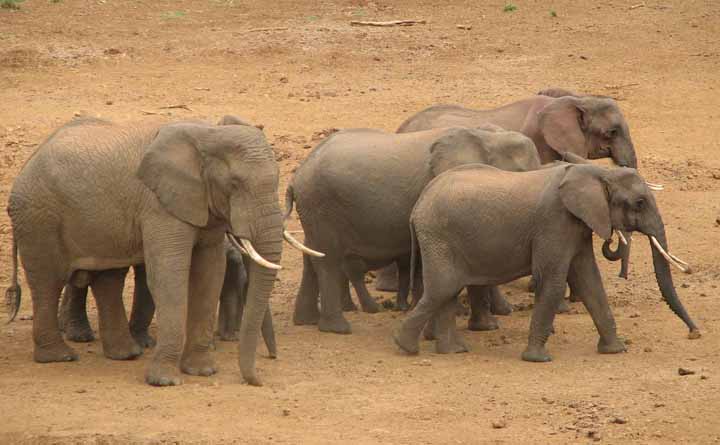
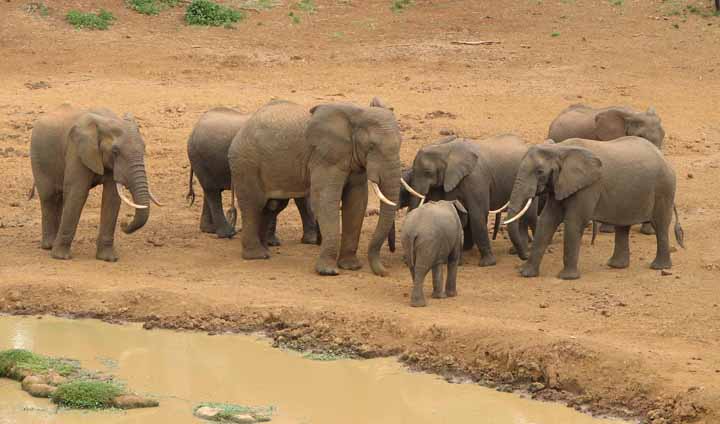
The most skittish visitor to the watering hole I saw was this bushbuck. It must have taken it 10 minutes to look around and slowly makes its way to the water. Then it was another 10 minutes drinking - having to look up every 30 seconds to see if anything was around. I guess that how you have to be if you're destined to be dinner for so many predators. Difficult to photograph because of the constant had movement.
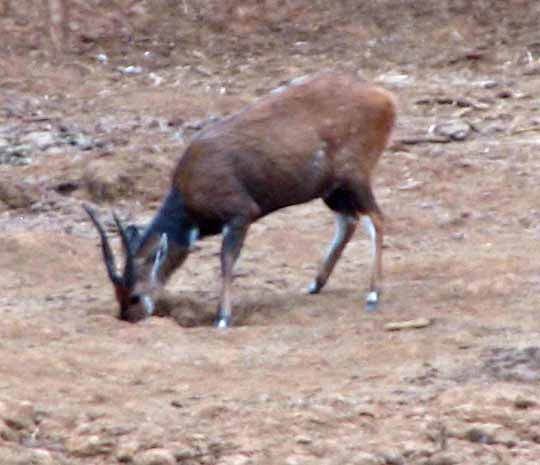
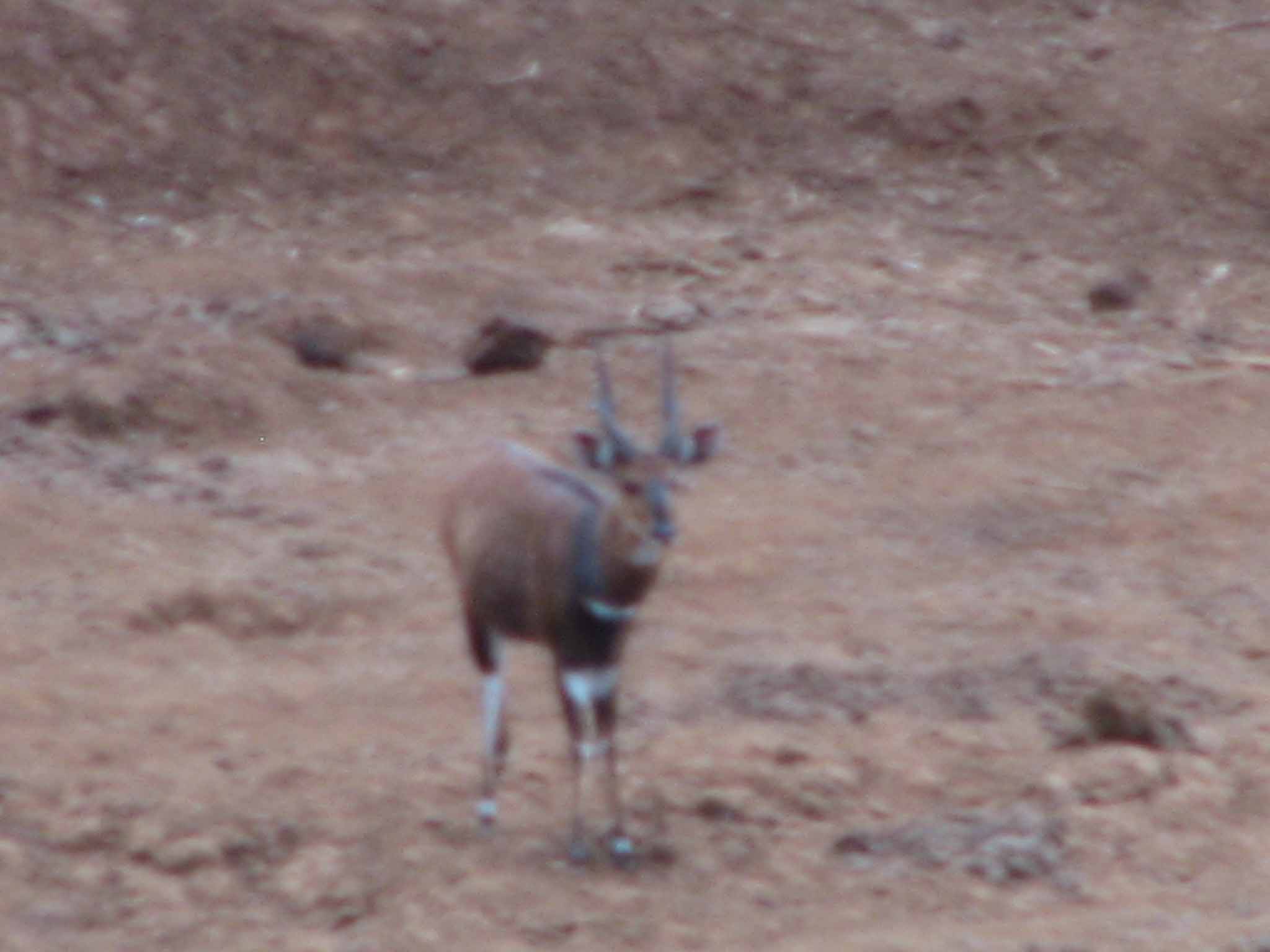
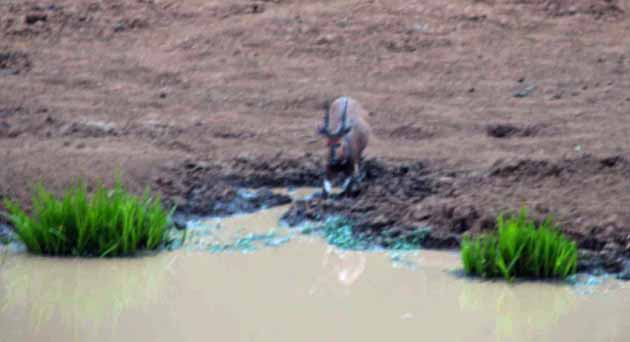
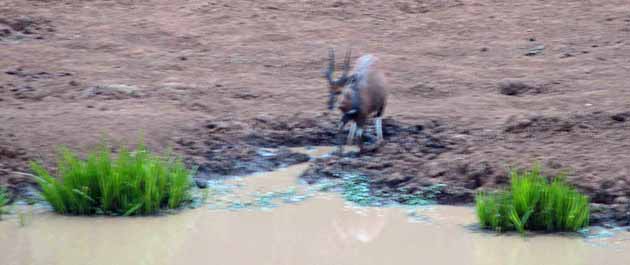
The First Safari
We signed up for a "Walking Safari". Not really certain what this meant, we pay our $35.00 USD each and hope this walk will be worth it. The lodge personnel tell us to be in the lobby at a certain time and be prepared for a 2 hour, 30 minute walk in the area around the lodge.
When we meet in the lobby, we sort through any number of heavy green rubber rain coats and even heavier Wellington boots. What a circus! Trying on coats in this temperature is sweaty business and attempting to pull on "Wellies", discarding the first or second pairs, until one finds a pair to almost fit.
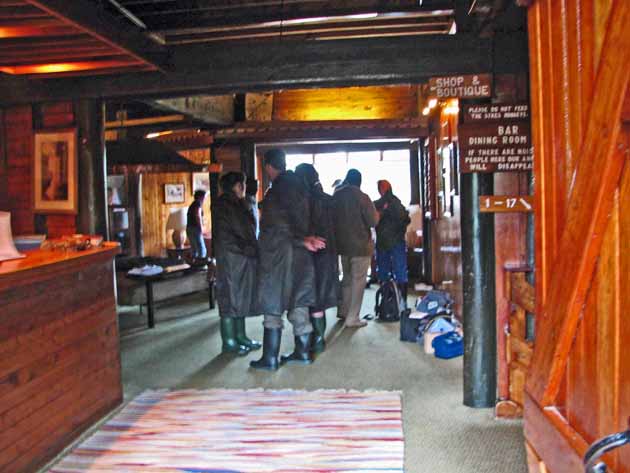
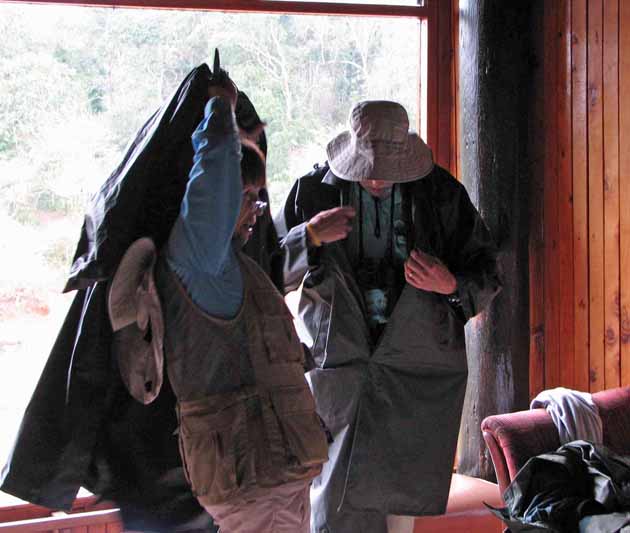
OK - how do we get this stuff on - do we really need it?
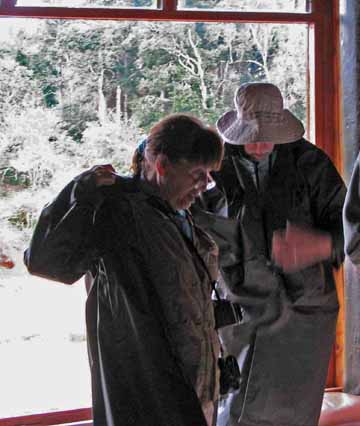 At least it doesn't button up the back!
At least it doesn't button up the back!
The Bobbsie twins on safari
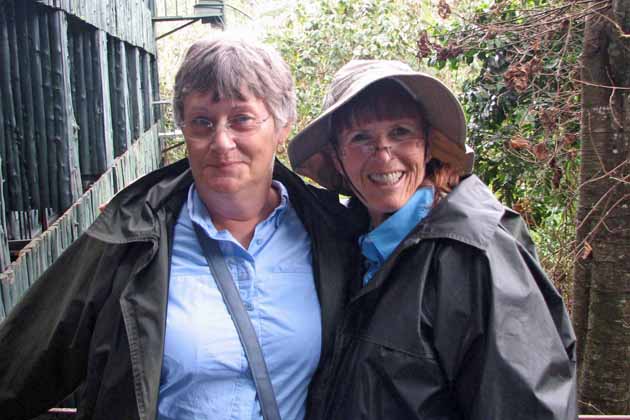 Yes Jackie, looks really slinky!
Yes Jackie, looks really slinky!
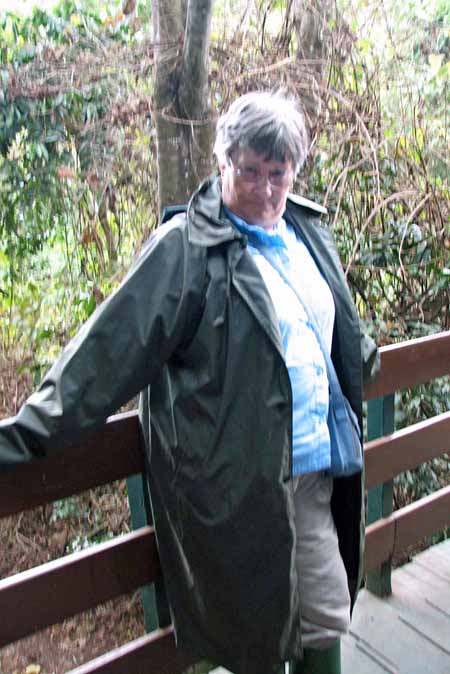
As it had sprinkled a few drops, we thought the gear was to protect against potential rain. Not until later did we find the raincoats actually were more for protection again pretty painful nettles and thorns, and the boots were more for protection against insects and bugs crawling up your legs to create havoc, than mud and water.
Out we go to meet our walk's guide. Standing with him, as we pass the "Do Not Go Unescorted" sign are two armed men. After a short discussion, during which the guide and the guards agree that as we are a smaller group, only one armed man is necessary.
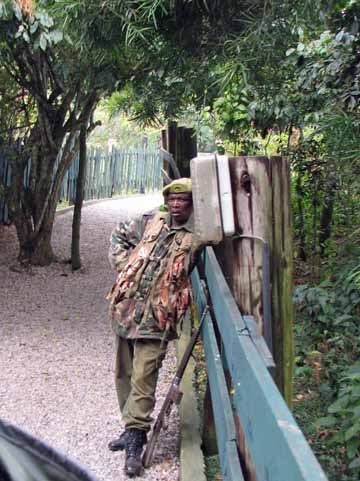
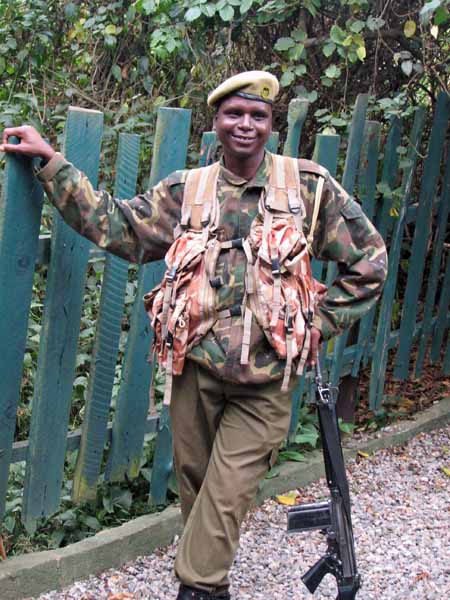
The one on the right ended up with us - the other one looks as if he'd shoot me!
Off we go into - don't want to call this a "jungle" as it doesn't fit my stereotype of jungle, but forest doesn't seem right either - the bush we go.
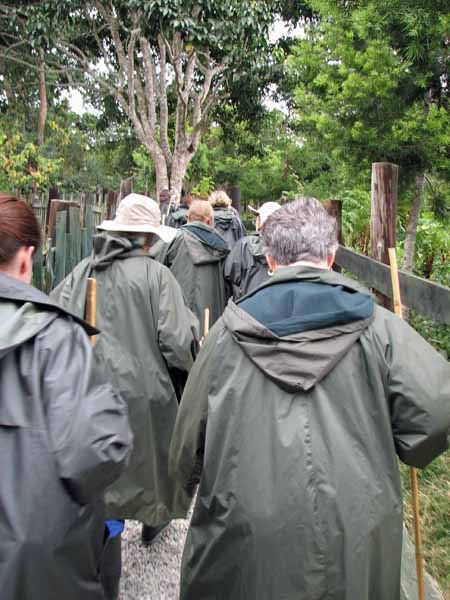
The guide warns us about nettles and suggest we walk where he walks. He explains we are walking on established game trails, not paths made by humans, and we may encounter wildlife at any time along the walk. The man with the automatic rifle is along because of the large number of Cape Buffalo.
He tells us that the Cape Buffalo is by far the most dangerous animal in the Park and is responsible for more human deaths in Africa than any other animal. He tells us that when shot, they have a habit of "playing opossum", lying still until the hunter approaches, only to jump up and kill the hunter and all that accompany him.
Another little Buffalo highlight is when he asked what should one do if seen by a Buffalo. We guessed: stand still, run in tight turns, try to climb a tree, etc. He told us o lie down, and if we were lucky the Buffalo would run over and stomp on us. If we were unlucky, he would bend over, hook us with his sharp horns, disembowel us and tear us to pieces.
Then the guide chuckles and turns to lead us down a game path.
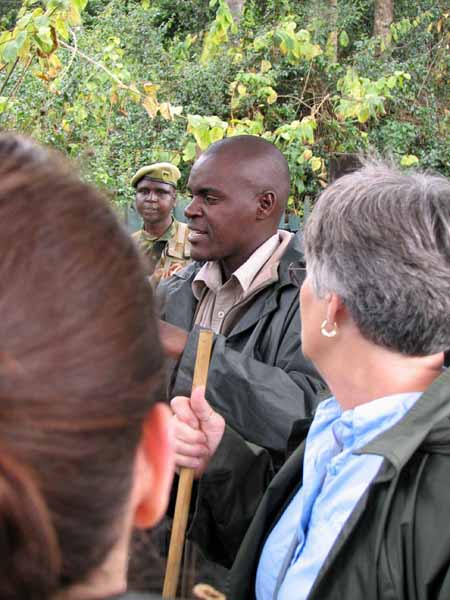
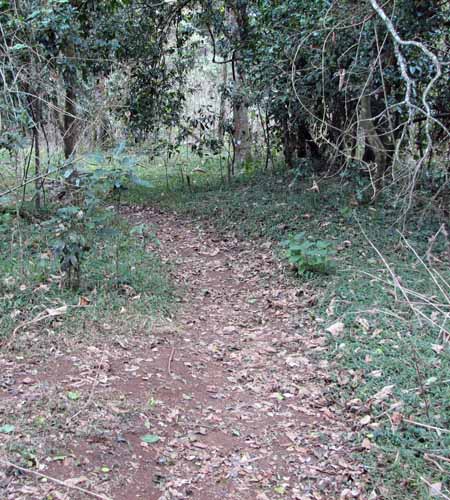
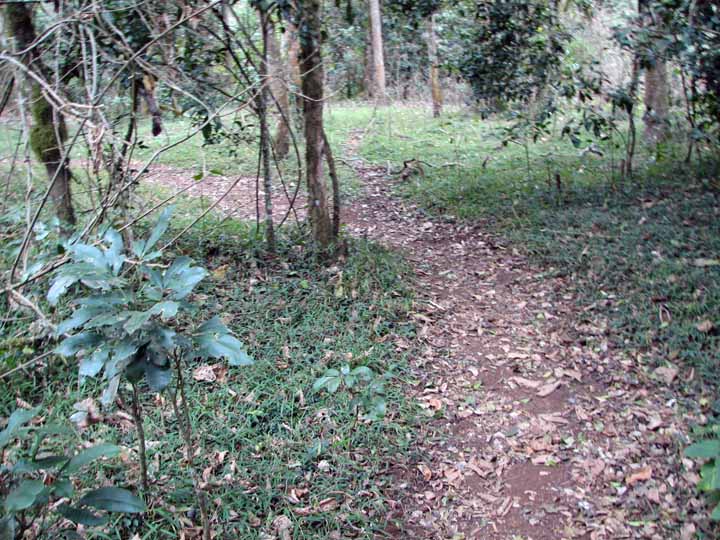
Animal or game trails through the brush
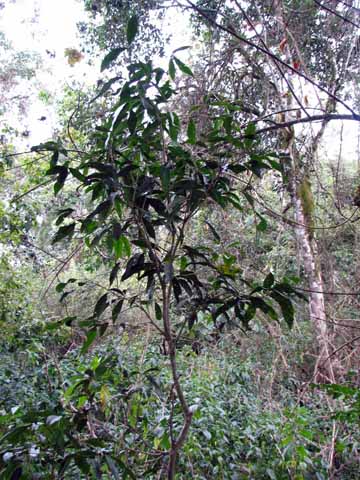 Coffee
growing wild.
Coffee
growing wild.
The tree below is the Baobab Tree -
It caught our eyes as soon as we saw it. Strangely beautiful and unlike any tree Jackie or I had ever seen. We initially thought it was Banyan, but it is totally different. We learned much more abut the Baobab Tree - See Tanzania pages
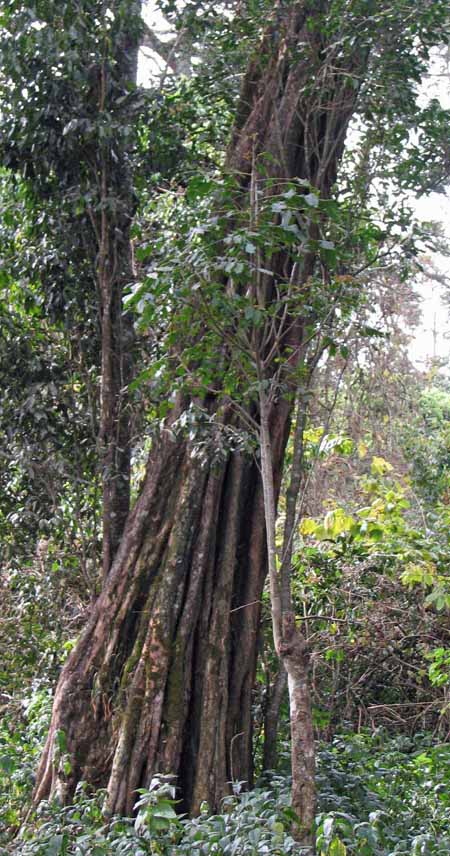
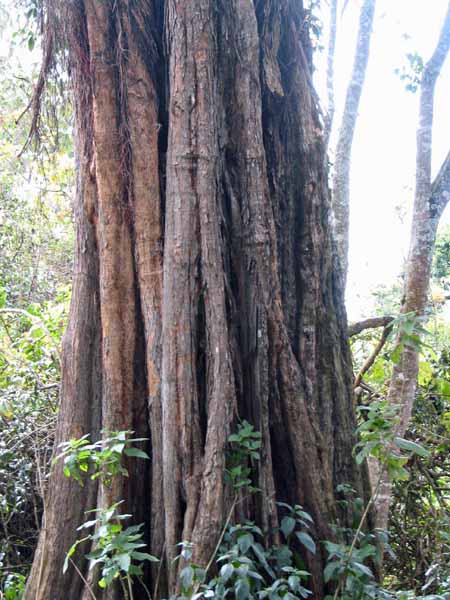
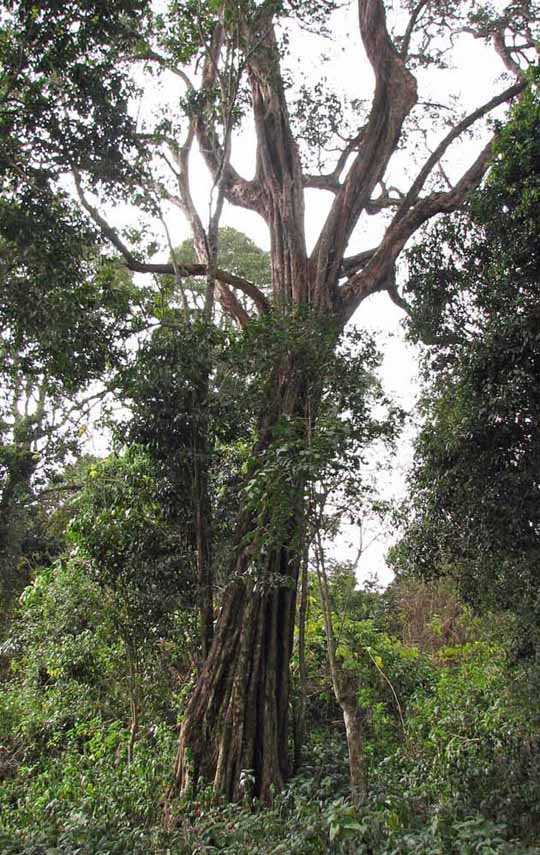
And we march, in single file, through the bush / jungle / forest
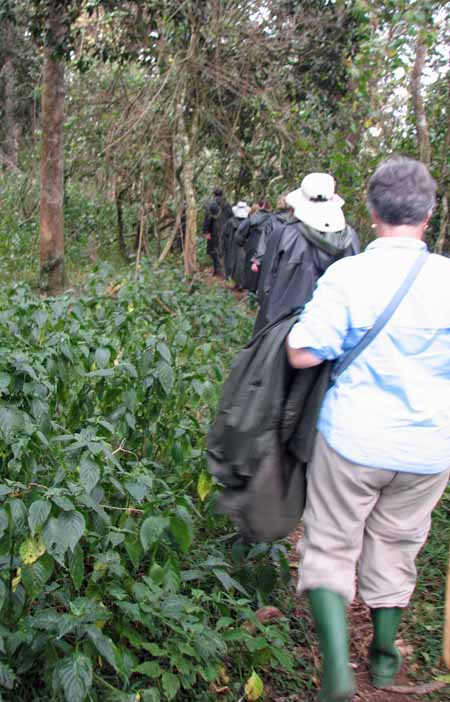
Finding unusual flowers and wild mangoes
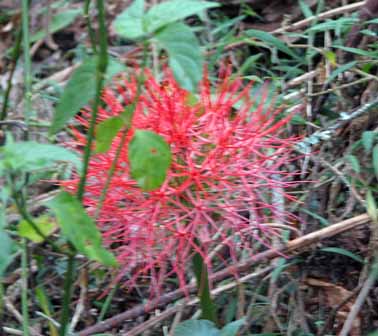
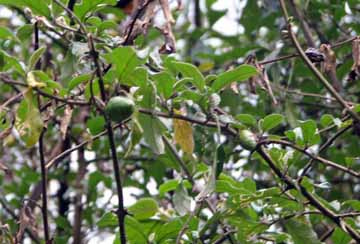
We discover a hole in the ground and
learn about anteaters and wart hogs. 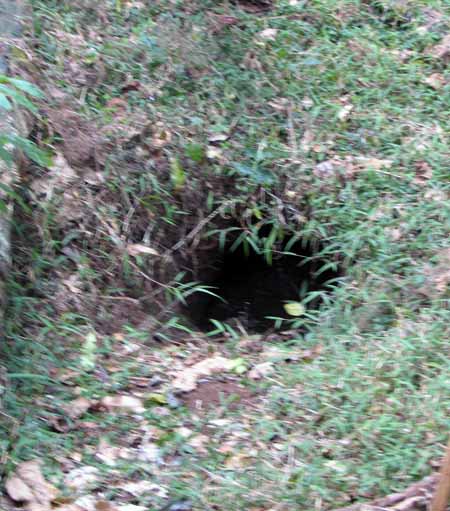
The anteaters love to dig to find ants, termites, worms and such. They will create a hole such as this. Wart hogs hide at night, and these burrows are perfect. The guide tells us they back into the burrow so they don't ever need to try to turn around. If the wart hog has a baby and/or a female, the baby goes in first, then the female, then the male. Whichever goes in first stands the chance of an encounter with a snake, and with the male last, and facing out, he can protect the female.
We stop very often for lectures from our guide. Always informative and often amusing. At one point we saw a line of large ants. I had seen these on TV and lacking a real name, called them "surgeon" ants, although he had an actual name for them. As the guide went on to explain, these ants can bite pretty dreadfully - one of the reasons we had on the boots was to keep them and other critters from climbing up our legs.
He grabbed one and showed us the powerful jaws. He told us that if one had a cut, needed stitches, and had no supplies, one could push the sides of the cut together and have the ant bite where they are pinched. One then tears the body of the ant from its head. The head will stay in place - the jaws holding the wound tight, and the saliva from the ant's mouth is an anesthesia. Pretty cool !
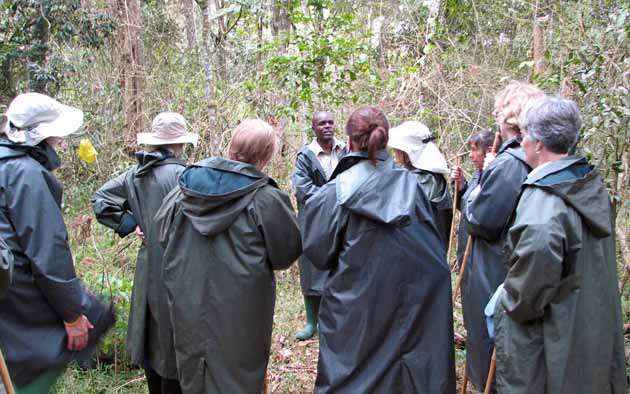
During one stop, I think while we were asking about the Pole Trees, I told the guide I saw something large and black way up in the taller trees a bit further along.
He stops his talk and we head down this path - he says we are going to see something important!
What we saw - or attempted to see - one of the rarest monkey in Africa,
The Colobus Monkey
Because the guide said it was not common for these walking safari's to see this monkey, he was very pleased we had the chance.
Then we saw them a second time. You could hear them going through the trees, yet they were so high up and the foliage both deep and dense, they were difficult to see clearly, much less photograph.
Then we saw them for the third time. The guide told us one sighting was truly uncommon, two sightings were very rare, and he said it was almost impossible to ever see them a third time - we were truly blessed.
I got a large number of shots- and nearly all were terrible. Believe me, these three were by far and away, the best I got.
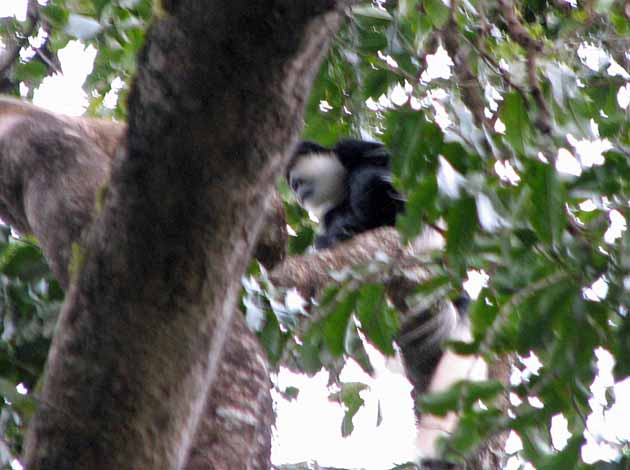
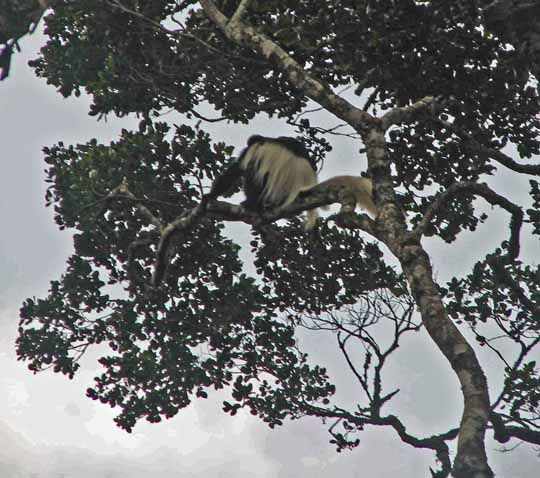
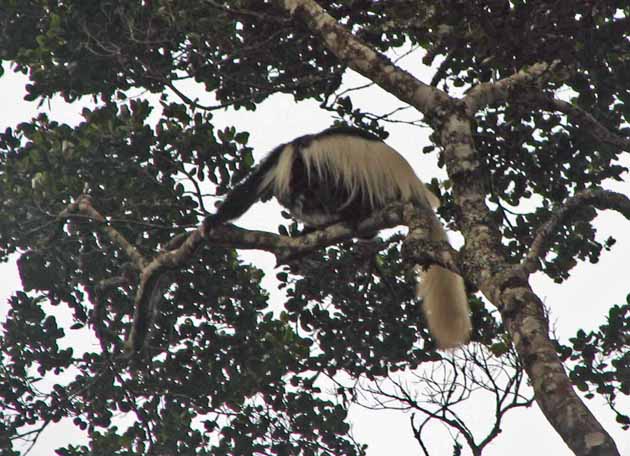
As they were in the very top of the trees for the most part, as you will see with these pole trees below, and as they were constantly on the move, you can image the difficulty taking their picture .
Yep, at least 100 feet tall, I'd guess. Our guide told us the wood from these trees is very valuable as the "poles" are very straight and they are pretty much rot proof. The main poles on our lodge are these pole trees and the lodge is over 40 years old.
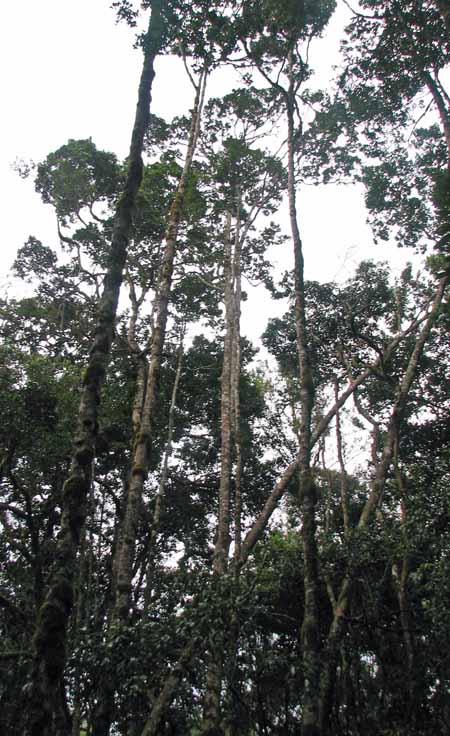
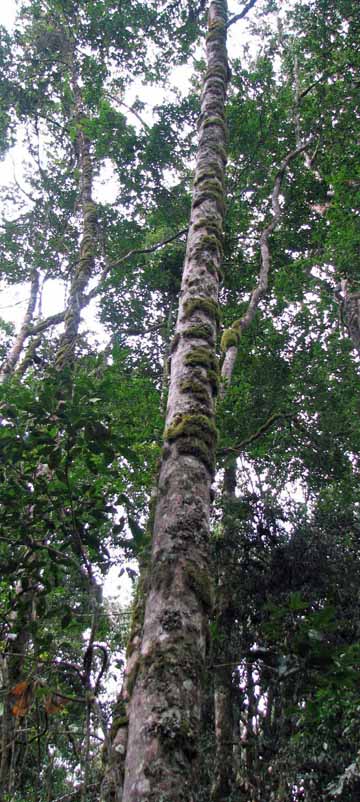
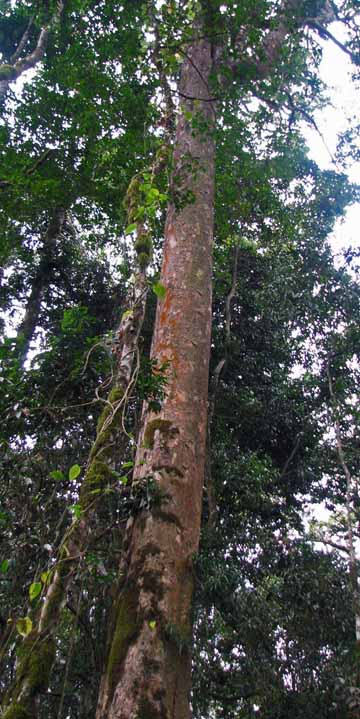
Because the Colobus Monkey experience was so striking, I looked them up and offer an edited version of what I found. (You may yawn or skip this part...)
~ ~ ~ ~~ ~ ~ ~ ~ ~ ~ ~ ~ ~ ~ ~ ~ ~ ~ ~ ~ ~ ~ ~ ~ ~
Colobus Monkey
Physical Characteristics
The name “colobus” is derived from the Greek word for “mutilated,” because unlike other monkeys, Colobus monkeys do not have thumbs. Their beautiful black fur strongly contrasts with the long white mantle, whiskers and beard around the face and the bushy white tail.
Habitat
Two types of black and white Colobus monkeys are found in Kenya those that inhabit coastal forests and those in inland high-country areas. Red Colobus monkeys are also found in East Africa, but are quite rare. Two other types of Colobus monkeys in Africa are the black and the olive. The Colobus lives in all types of closed forests.
Behavior
The Colobus is the most arboreal of all African monkeys and rarely descends to the ground. It uses branches as trampolines, jumping up and down on them to get liftoff for leaps of up to 50 feet. They leap up and then drop downward, falling with outstretched arms and legs to grab the next branch. Their mantle hair and tails are believed to act as a parachute during these long leaps.
Colobus monkeys live in troops of about 5 to 10 animals - a dominant male, several females, and young. Each troop has its own territory which is well defined and defended from other troops. Adult troop members, especially males, make croaking roars that can be heard resonating throughout the forest.
The newborn Colobus monkey is covered with white fur, and at about 1 month gradually begins to change color, finally gaining the black and white adult coloration at about 3 months. The infant monkey is carried on the mother's abdomen, where it clings to her fur. As it matures it spends a lot of time playing with its mother and certain other adults and at about 7 months begins playing with other juveniles. The games they play exercise their bodies, and as they get older, these develop into wrestling matches and mock displays.
Diet
Colobus monkeys are strictly leaf-eaters and spend most of their time in treetops, preferring to eat the tender young leaves found there. However, complex stomachs enable them to digest mature or toxic foliage that other monkeys cannot.
Predators and Threats
At one time the Colobus was hunted excessively for its beautiful fur, leading to its extermination in some areas. Its skin has been used to make dance costumes, hats and capes. Today, the greatest threat to its continued existence comes from loss of habitat as forests are cut down.
~ ~ ~ ~~ ~ ~ ~ ~ ~ ~ ~ ~ ~ ~ ~ ~ ~ ~ ~ ~ ~ ~ ~ ~ ~
And now, onward through the game trials
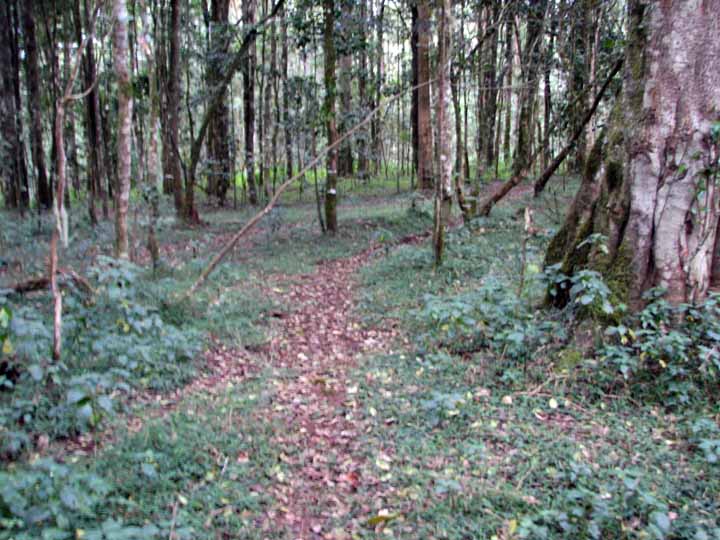
At one stop the guide shows us a plant that has several purposes as "jungle medicine".
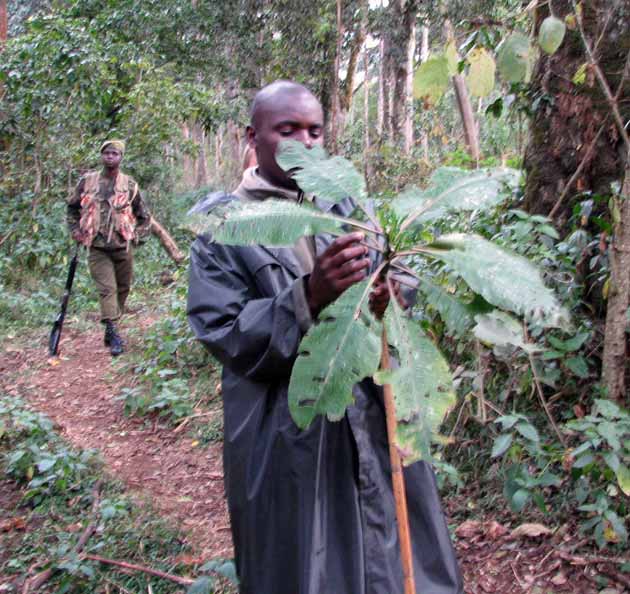
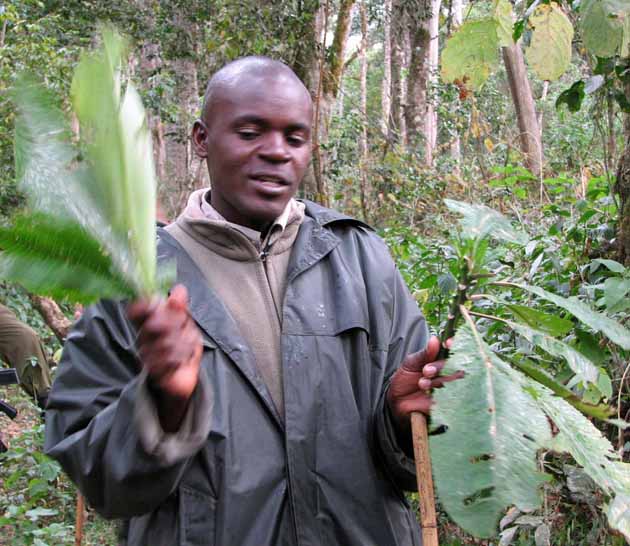
Although I cannot recall everything he said, I believe the leaves were for one thing, the sap for another, and the roots for a third. I'll have to look in Jackie's journal or hear from one of our fellow travelers.
AND AS HE TALKED - one of the our troop gave a yell and started jumping around. It seems we had found another group of stinging ants and some folks were standing among them . An ant had somehow crawled up a young lady's leg and had bitten. Then it starting moving even further. Finally several of us held our raincoats to shield her as she dropped her pants to frantically search for the ant. It must have been brushed off as she struggled, as it was not found.
Needless to say, we all double checked to make certain our pants were tucked firmly in our boots!
Some of the trees we saw were beyond weird! How about this tree with these spikes.
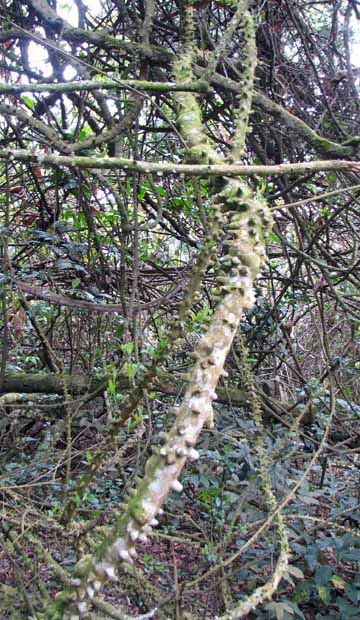
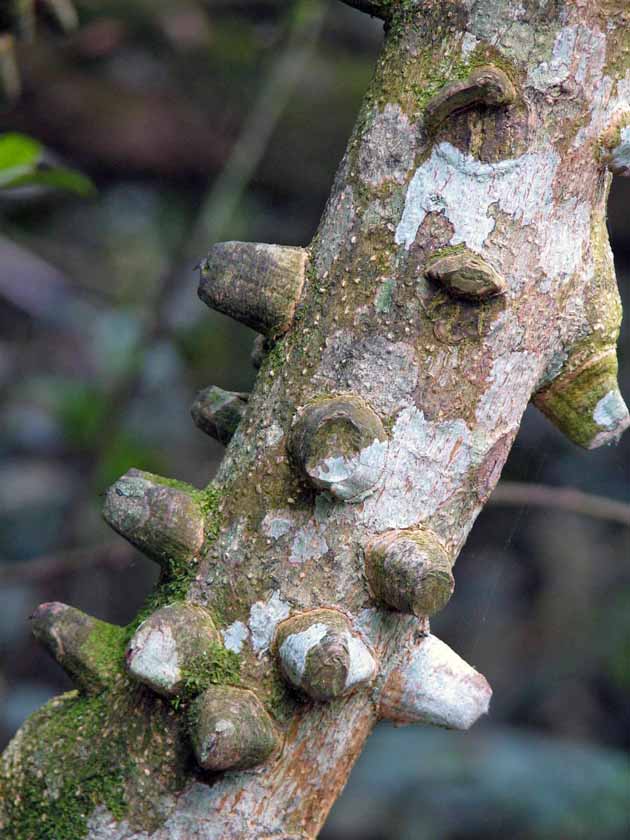
Lo and Behold - here, two hours into the jungle, as we grow hot and tired, we come upon a clearing. In that clearing is some long tree benches, fronted by individual little coffee table.
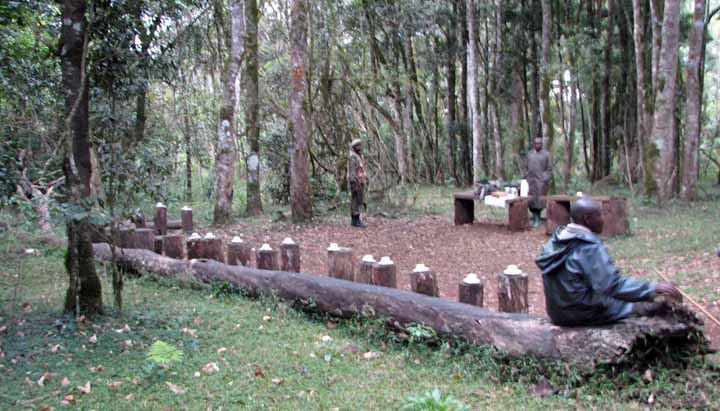
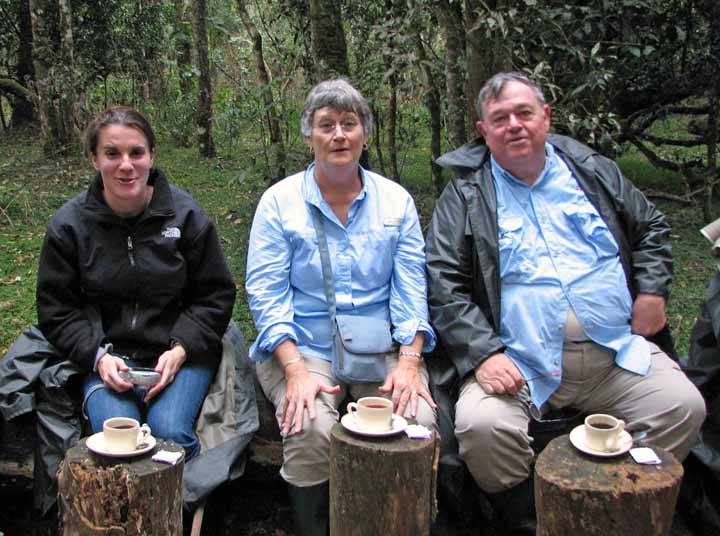 We
sat and enjoyed cool drinks, tea or coffee. If one selected coffee, as I
did, one was offered white or "brown" milk. I opted for the
brown milk and it was the strongest, rawest whiskey I ever drank. Quite a
pick me up. Allison and Jackie wimped out and had white milk.
We
sat and enjoyed cool drinks, tea or coffee. If one selected coffee, as I
did, one was offered white or "brown" milk. I opted for the
brown milk and it was the strongest, rawest whiskey I ever drank. Quite a
pick me up. Allison and Jackie wimped out and had white milk.
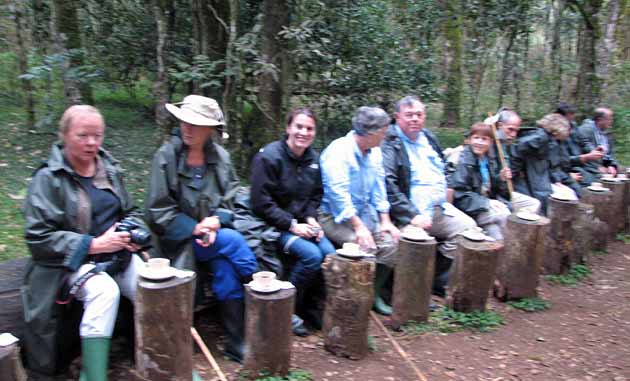
A long line of jungle coffee fiends....
As we neared the end of the safari we approached several sets of bones. Those below were from Cape Buffalo.
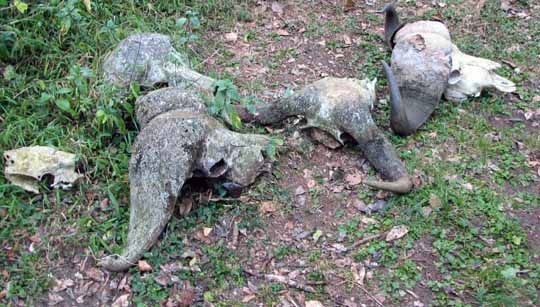
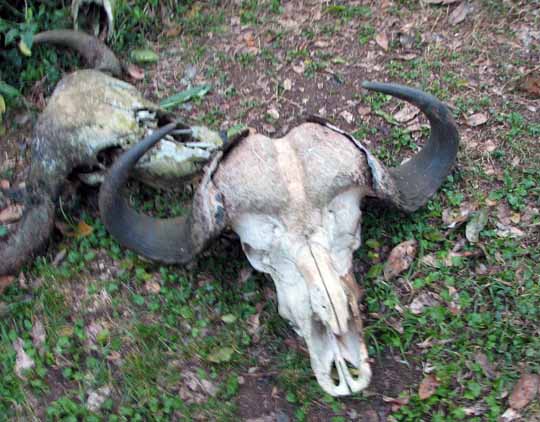
Those below are mostly from elephants.
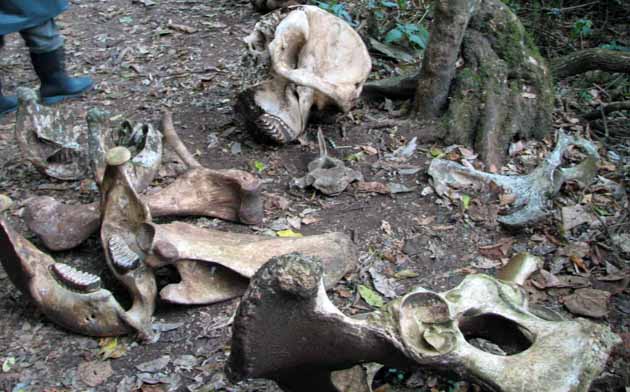
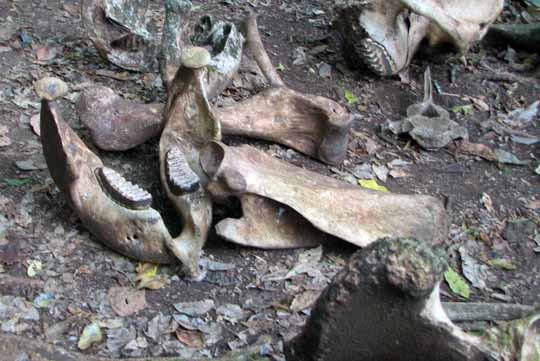
The guide points out the elephant's skull. It looks almost like a sponge; full of spaces and empty areas. He tells us that if the elephant's skull were solid bone, it would be too heavy to lift. This structure is both lighter and strong.
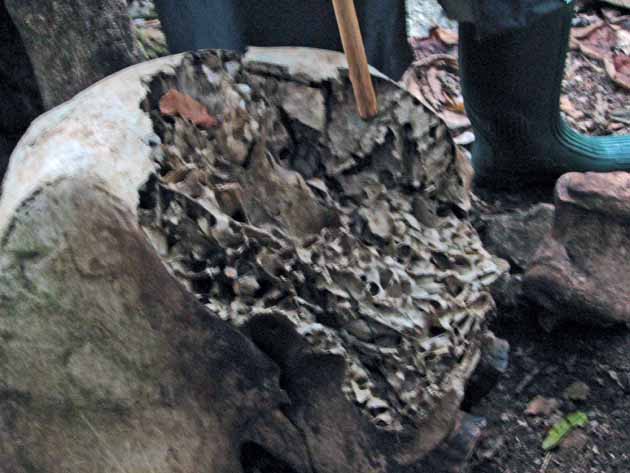
He tells us the elephant bones are hard to keep. I expected to hear about poaching or some other arcane use of the bones, but the explanation floored us. It seems that if local elephants come across the pile of elephant bones, they don't want them on display and they pick them up and scatter them!
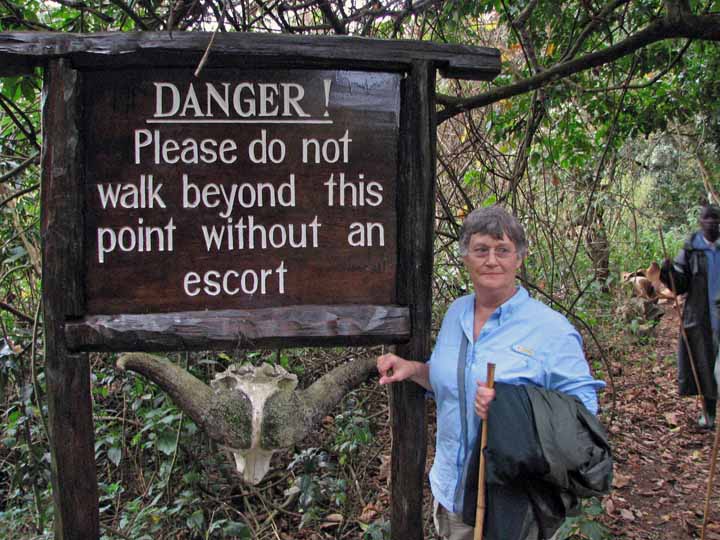
Jackie made it safely though her walking safari.
( By the way, with a couple very small exceptions, this was the only time we were ever allowed to walk through wild areas - armed guard or not. )
Back to the lodge - we were out closer to 3 and 1/2 hours than 2 and 1/2 hours - and the time was very well spent. This was actually an excellent introduction to Kenya's parks and reserves, very instructional, and a great way for this group of individual strangers to become a troop of companions.
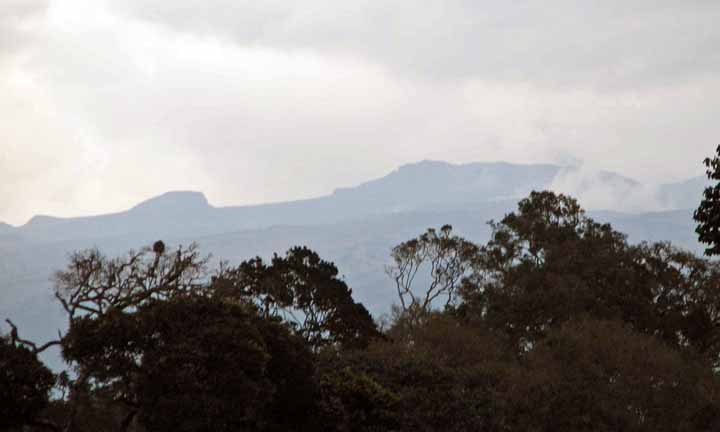 The
mountains in the distance challenged one to take a picture showing their shades
of color.
The
mountains in the distance challenged one to take a picture showing their shades
of color.
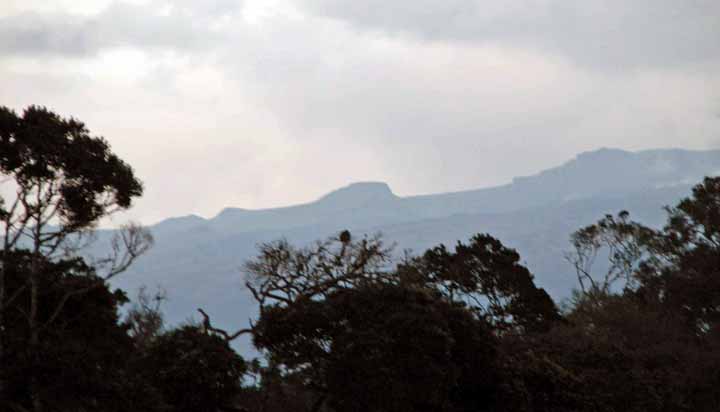
After a great dinner, with the monkeys looking at us and pretending to be so
starved and needy, as they try to pry the lovers of the windows open, we're back
to our rooms to watch the water hole. Occasional visits by monkeys
occur.
Jackie had one "run-in" when a monkey joined us as we watched the water hole. After sitting a moment looking at Jackie, he/she reached over and grabbed Jackie's arm. Although Jackie wanted to pull away, she hesitated and the monkey smelled and felt her sleeve - rubbing the material between its fingers. Enough was enough, and Jackie took back possession of her arm and shooed he monkey away.
Animals came and went to the water hole as darkness fell, and then well placed flood lights very gently illuminated the water hole all night. While it was lighted enough to see, I couldn't take pictures. Sadly, just as darkness fell, two of the animals this area is most famous for wandered in - giant forest hogs. Oh well.
He's gazing into the dining room, looking sad and hungry. He's thinking,
"If I can get my fingers just a bit further in this window, dinner is mine!"
Notice all the finger and nose prints in the window.
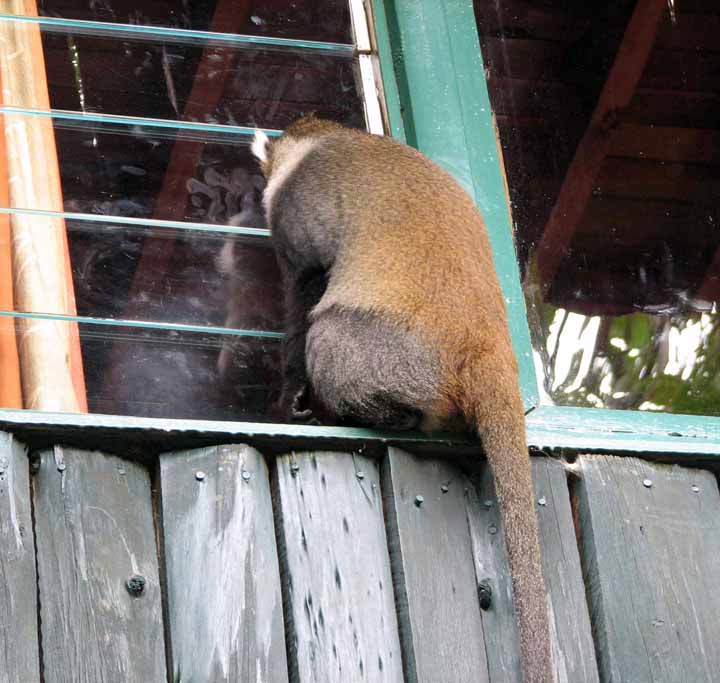
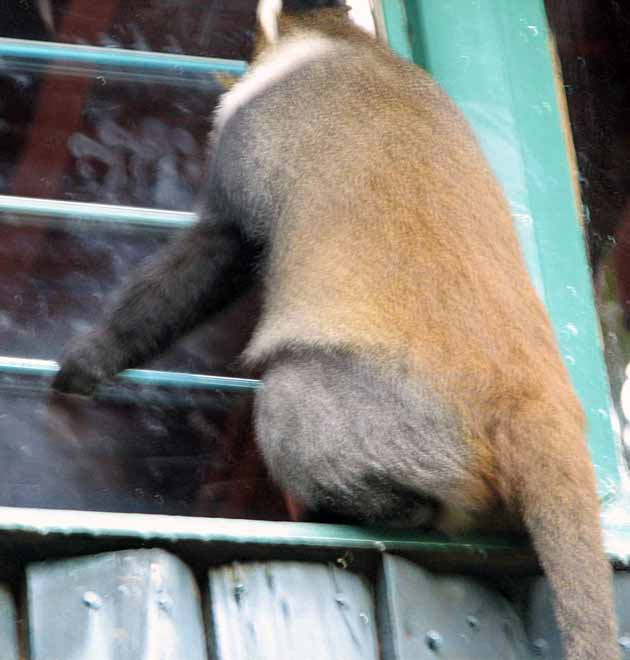
Others visit our balcony, often taking a moment to pee on the shelf attached to the banister.
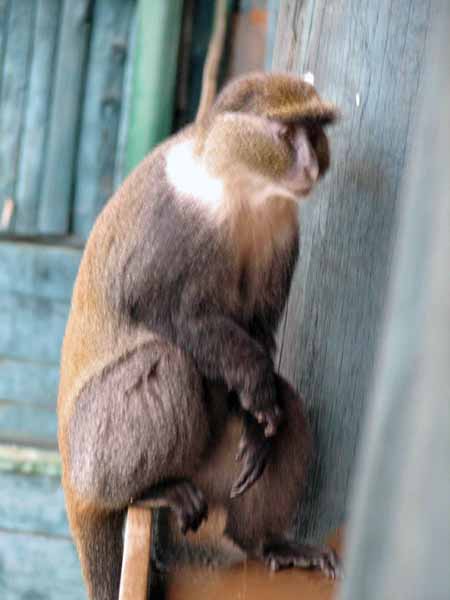
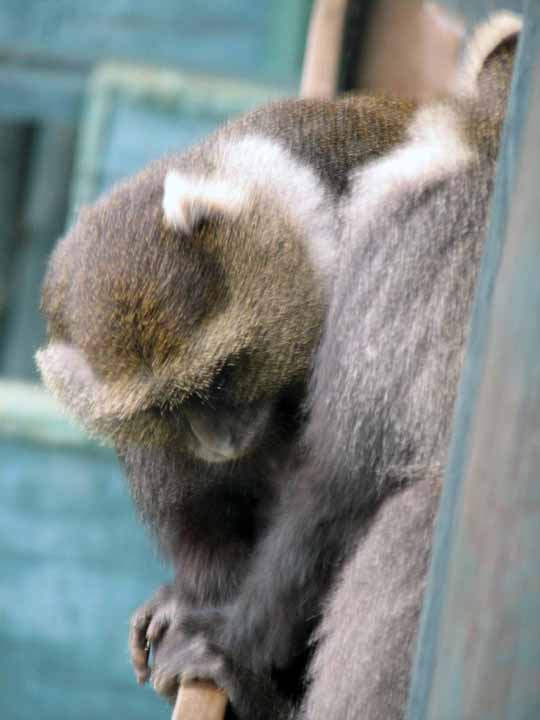
Oh, did I mention the elephants? You can NEVER have enough elephants.
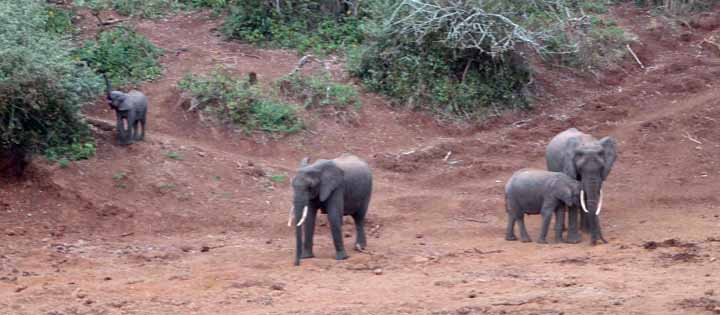
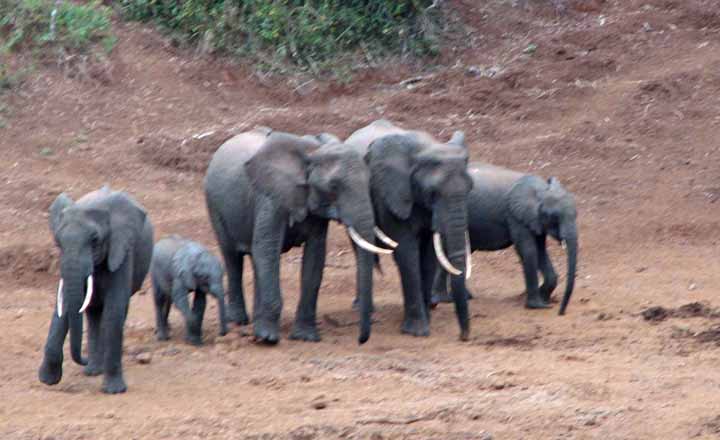
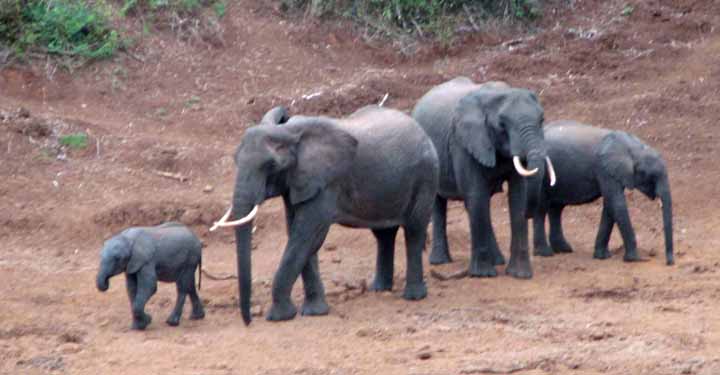
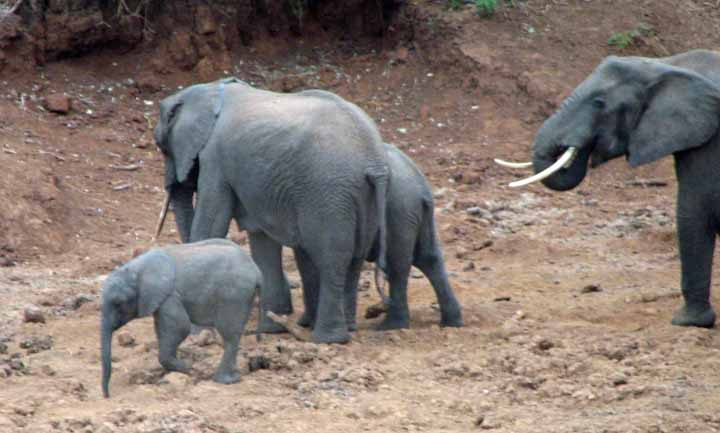
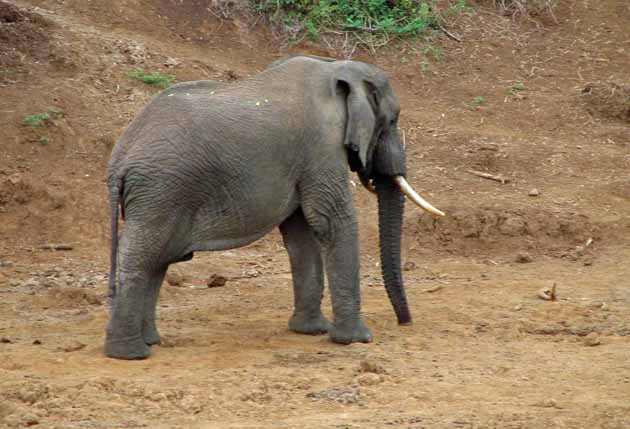
Unfortunately -
It was too dark for my camera to take pictures, even though we could see pretty clearly, so I didn't get pictures of some of the visitors we had on the platform and closer to the lodge at dusk and then at night.
We saw striped mongoose, the brown mongoose and the rarer white tailed mongoose. They were the reason the bones on the platform were wired down. The mongooses came repeatedly to chew on the bones. We had a visit from an African Scrub Hare. We saw the first of many Dik Dik's and two Giant Forest Hogs.
Deer walked right up to the building to eat grass during the night and huge Forest Hogs came to visit - really huge! Other animals were too close to the trees and brush to make out clearly, but it seemed as soon as you might think it's time for bed, something else would wander out.
I've got to admit I was up maybe six times during the night, going out to the balcony because I didn't want to miss anything going on. I was one of a very large group of sleepy people at breakfast the next morning - it seems no one wanted to miss the water hole action!
After all, this is the Mount Kenya Park, so we tried to see Mount Kenya. This proved to be difficult. It appears Mount Kenya, much like Mount Denali or Mount Rainier, is seldom photographed totally exposed. These pictures were from our balcony, and I have two other sets of Mount Kenya picture from later in the trip, but these might be the best.
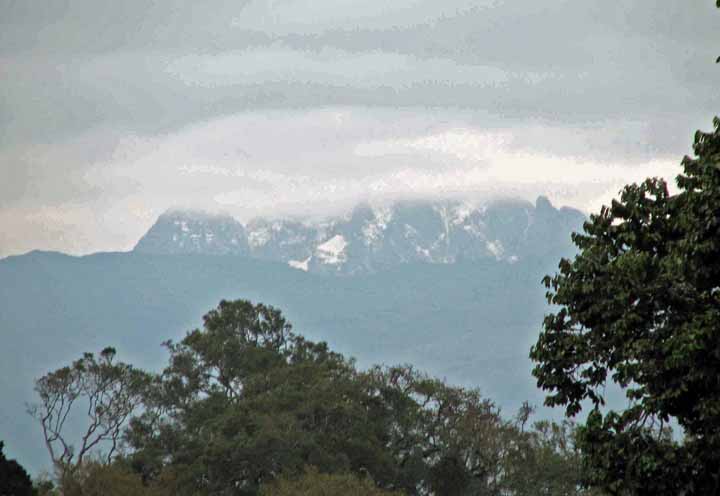
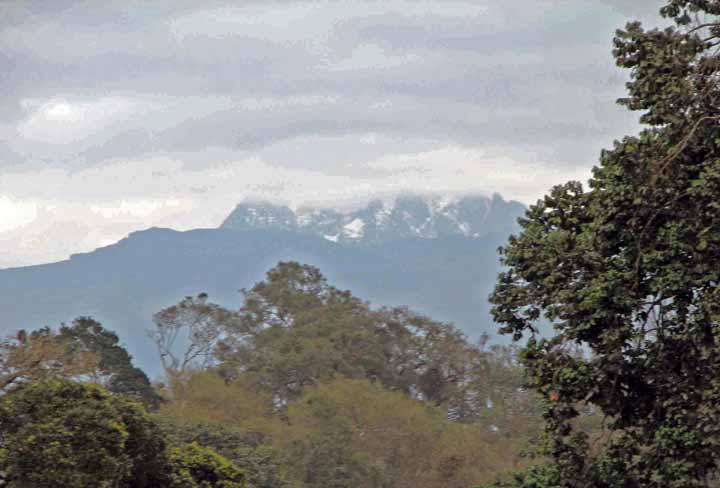
Ok, out to the van, good bye to Serena Lodge -
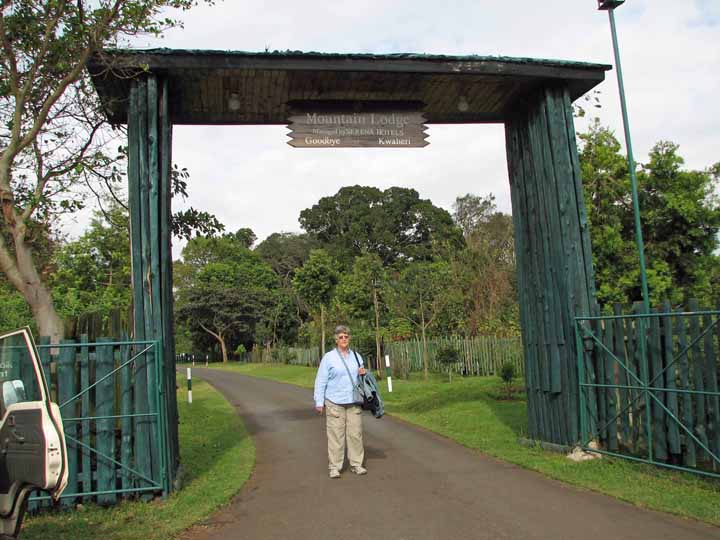 and the Mount Kenya National Park.
and the Mount Kenya National Park. 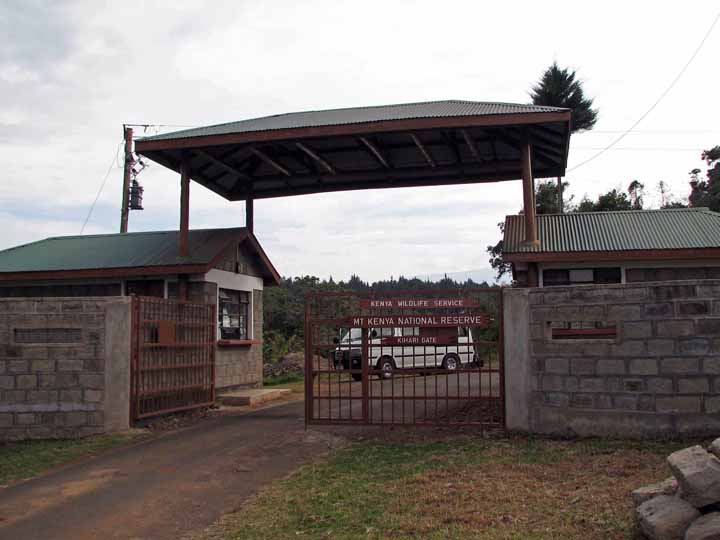
Hold on your your kidneys and everything else that might bruise or bust - we're on Kenya's excuse for roads again!
On our way to Samburu.
~ ~ ~ ~ ~ ~ ~ ~ ~ ~ ~ ~ ~ ~ ~ ~ ~ ~ ~ ~ ~ ~ ~ ~ ~ ~ ~ ~ ~ ~ ~ ~ ~ ~ ~ ~ ~ ~ ~ ~ ~